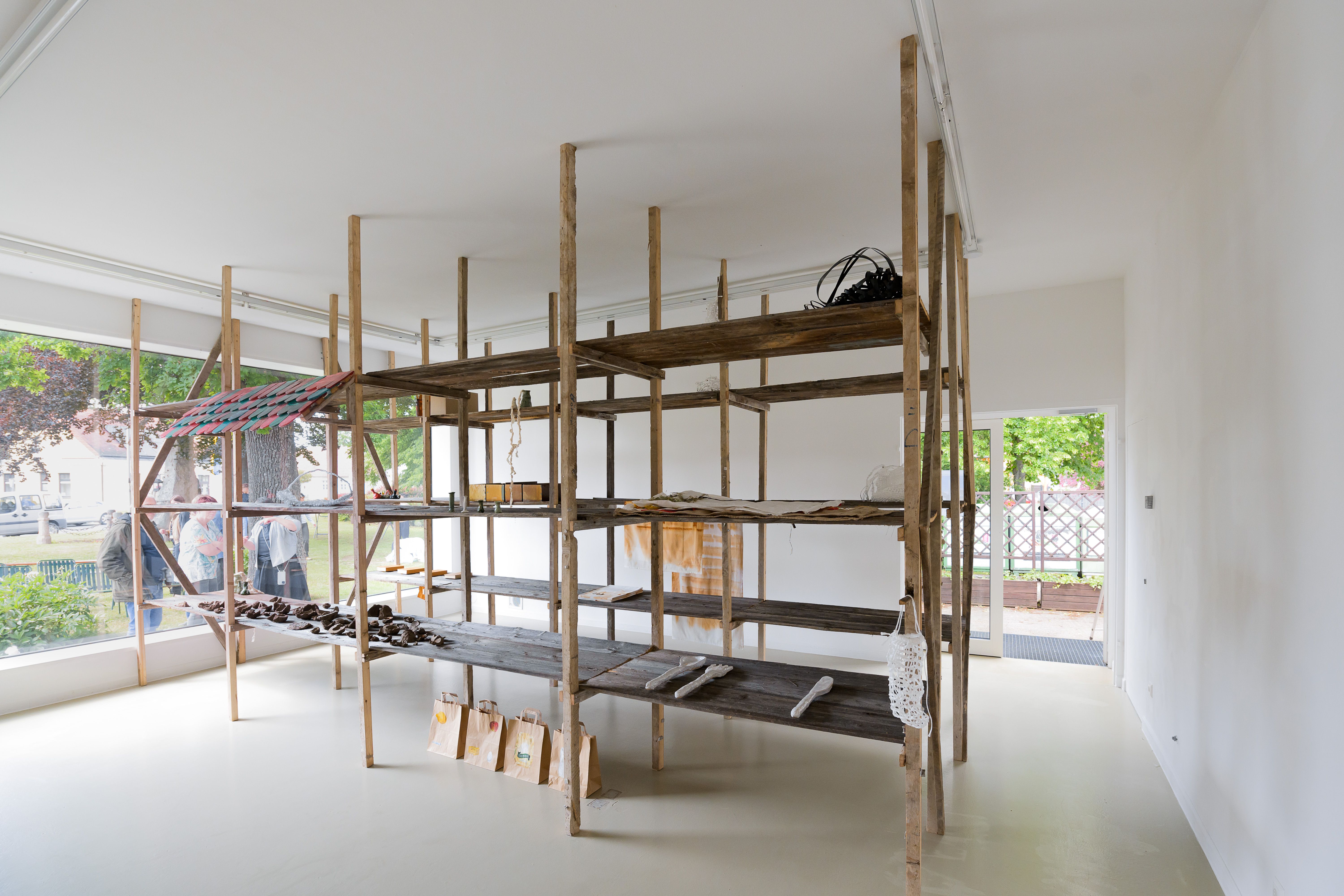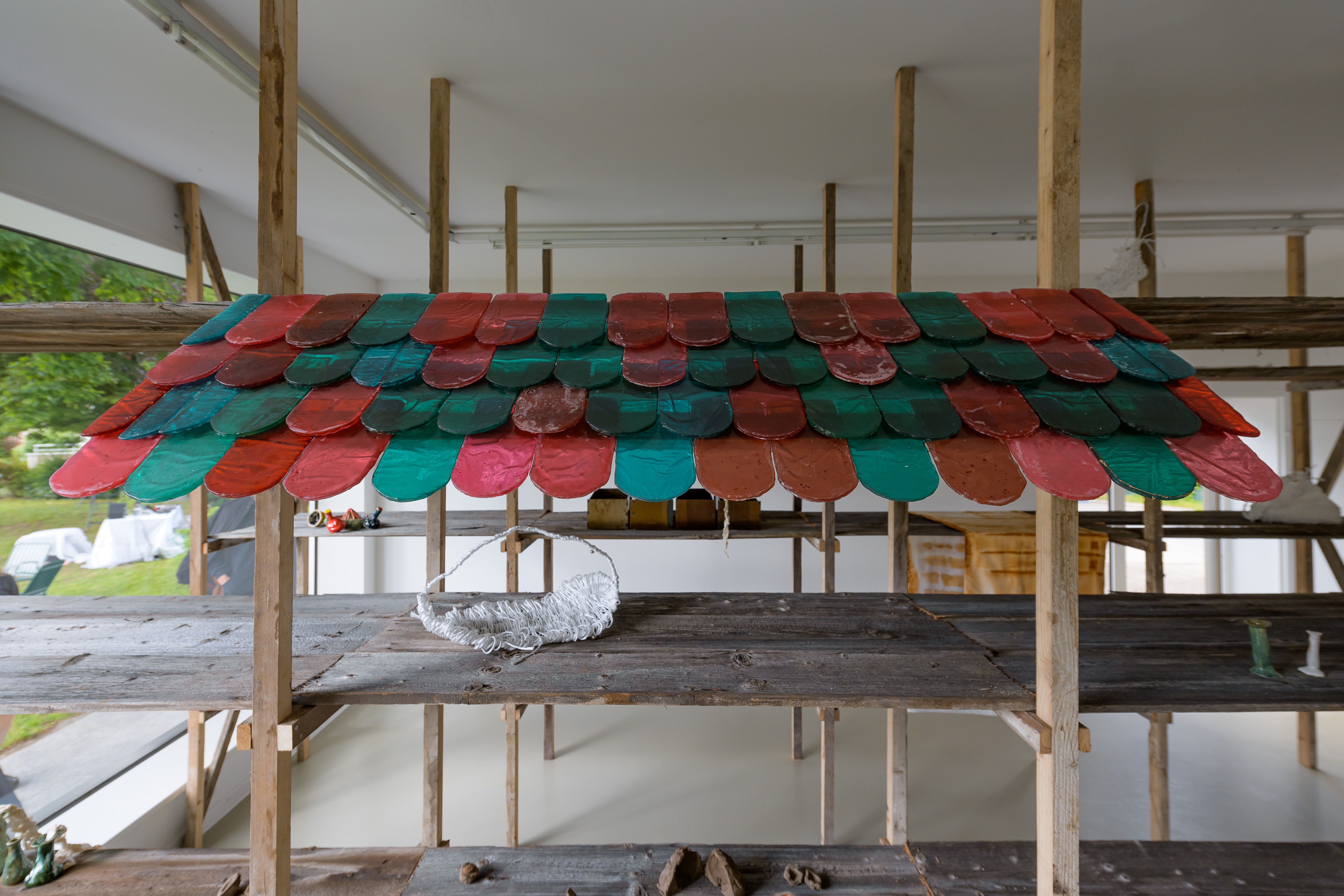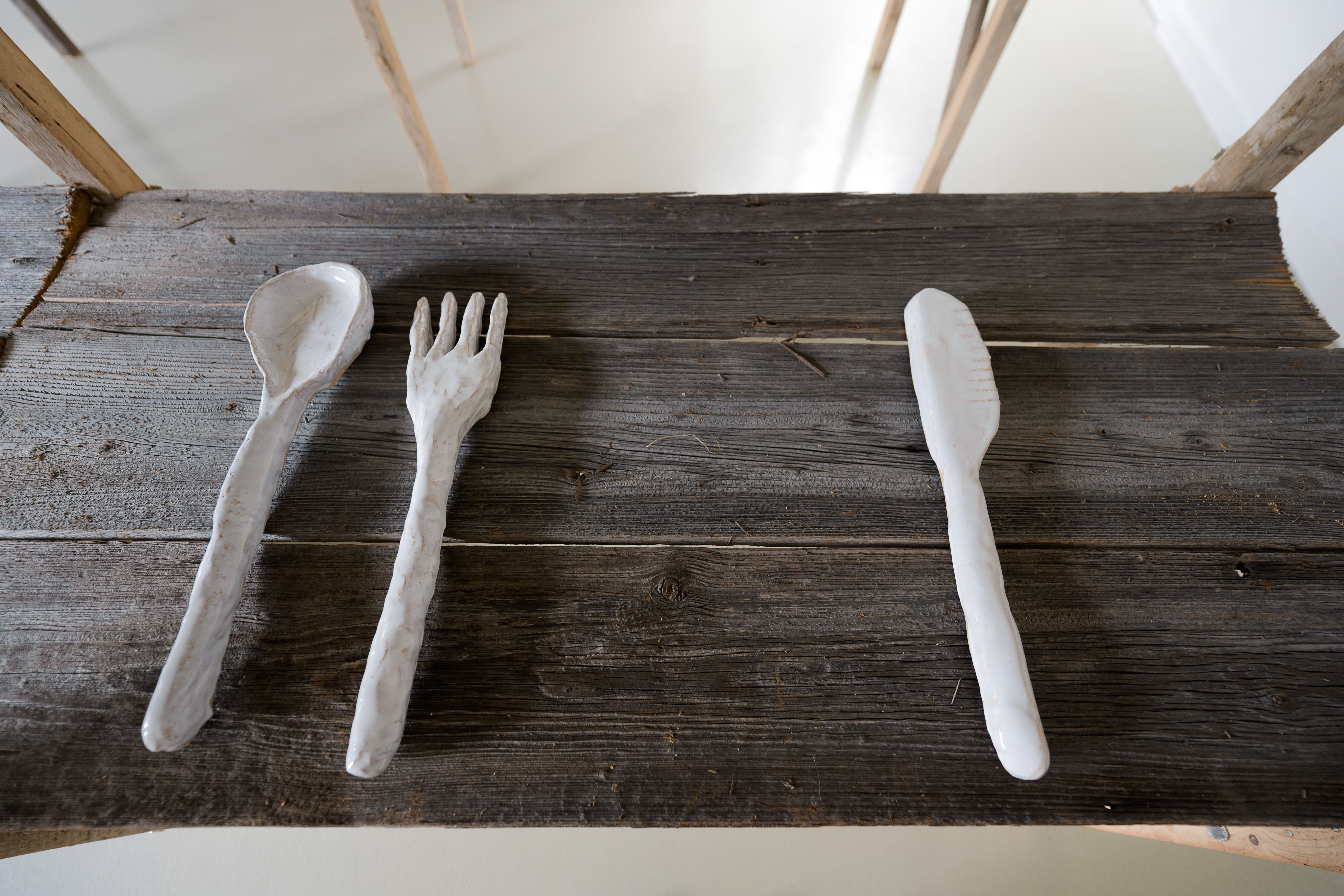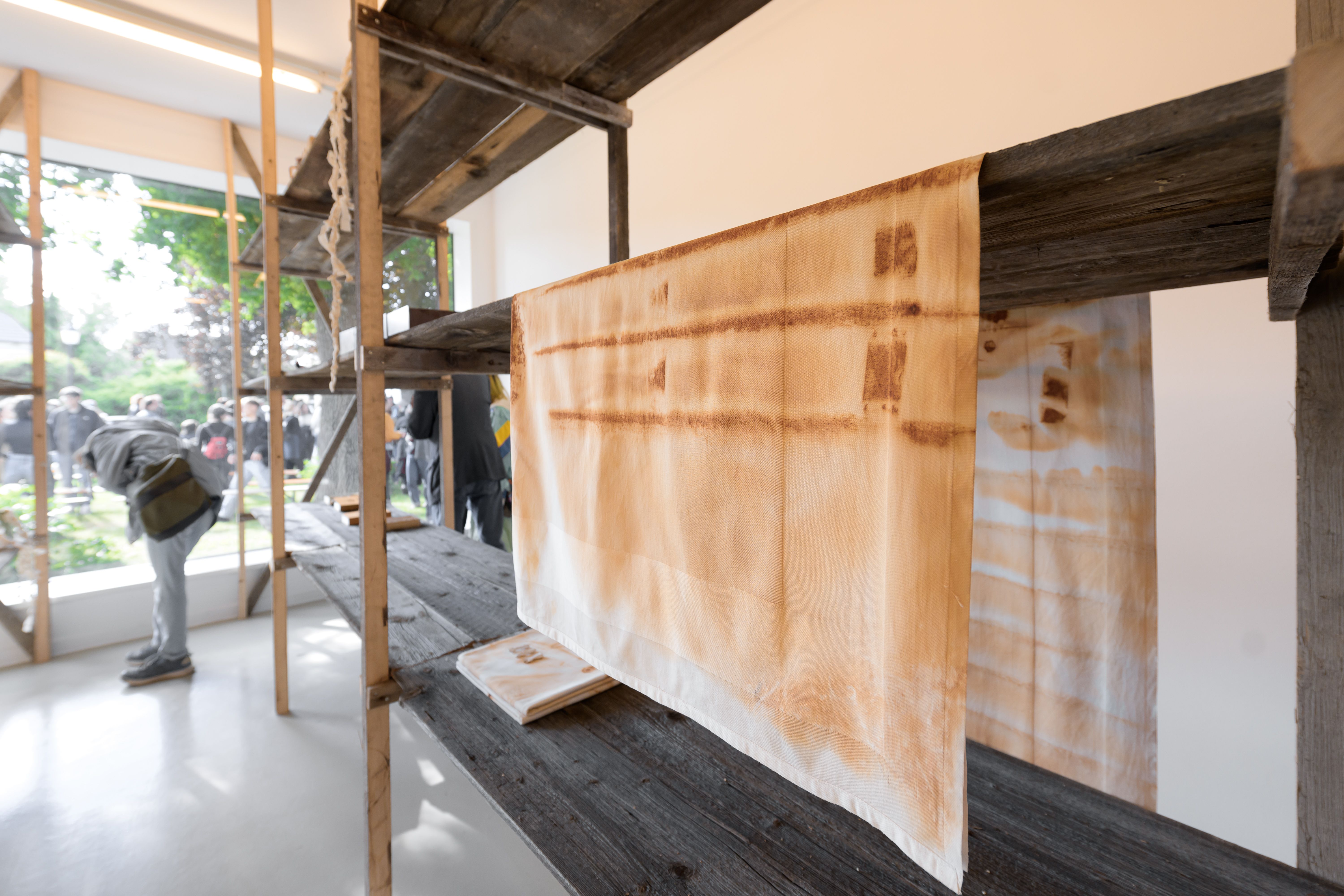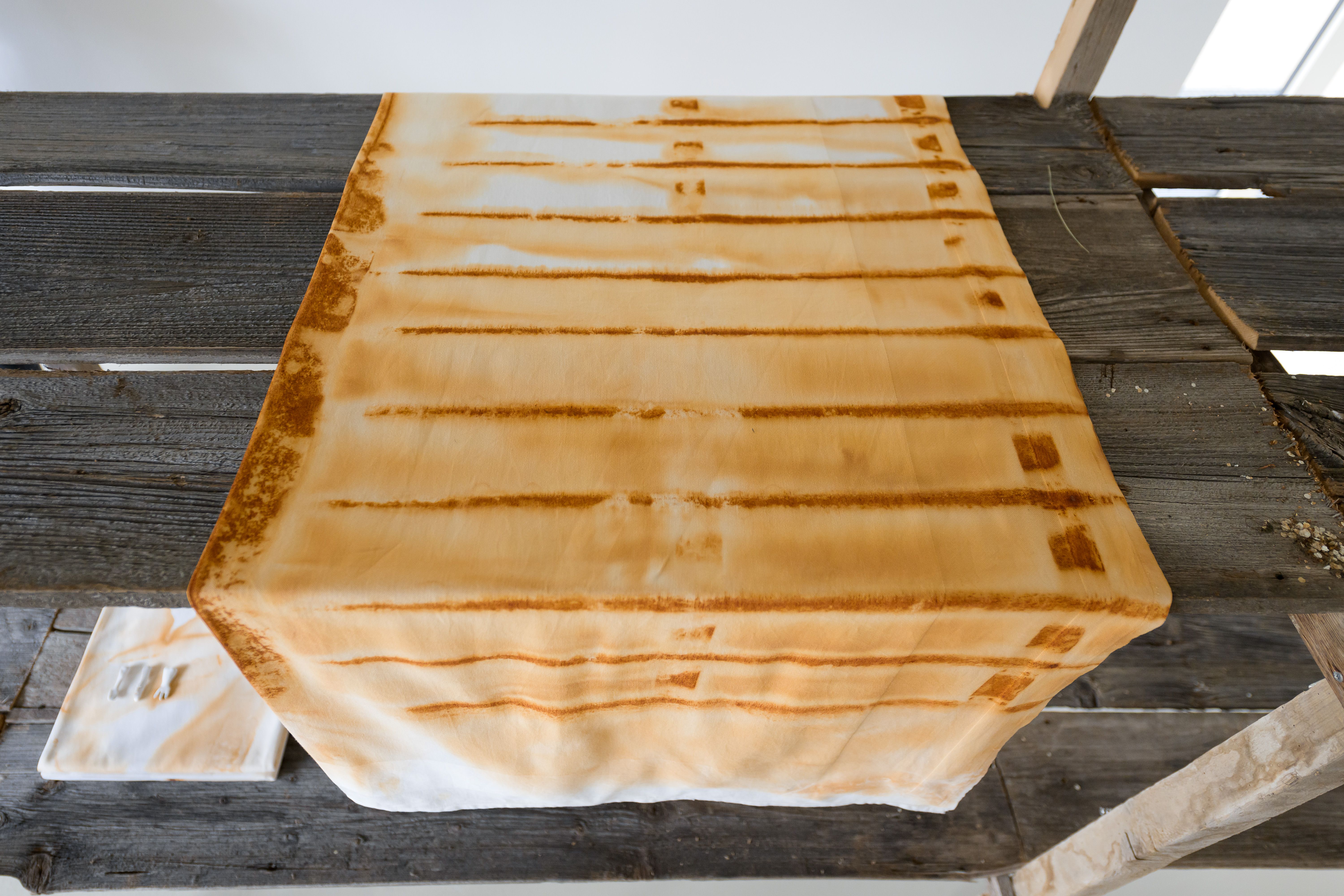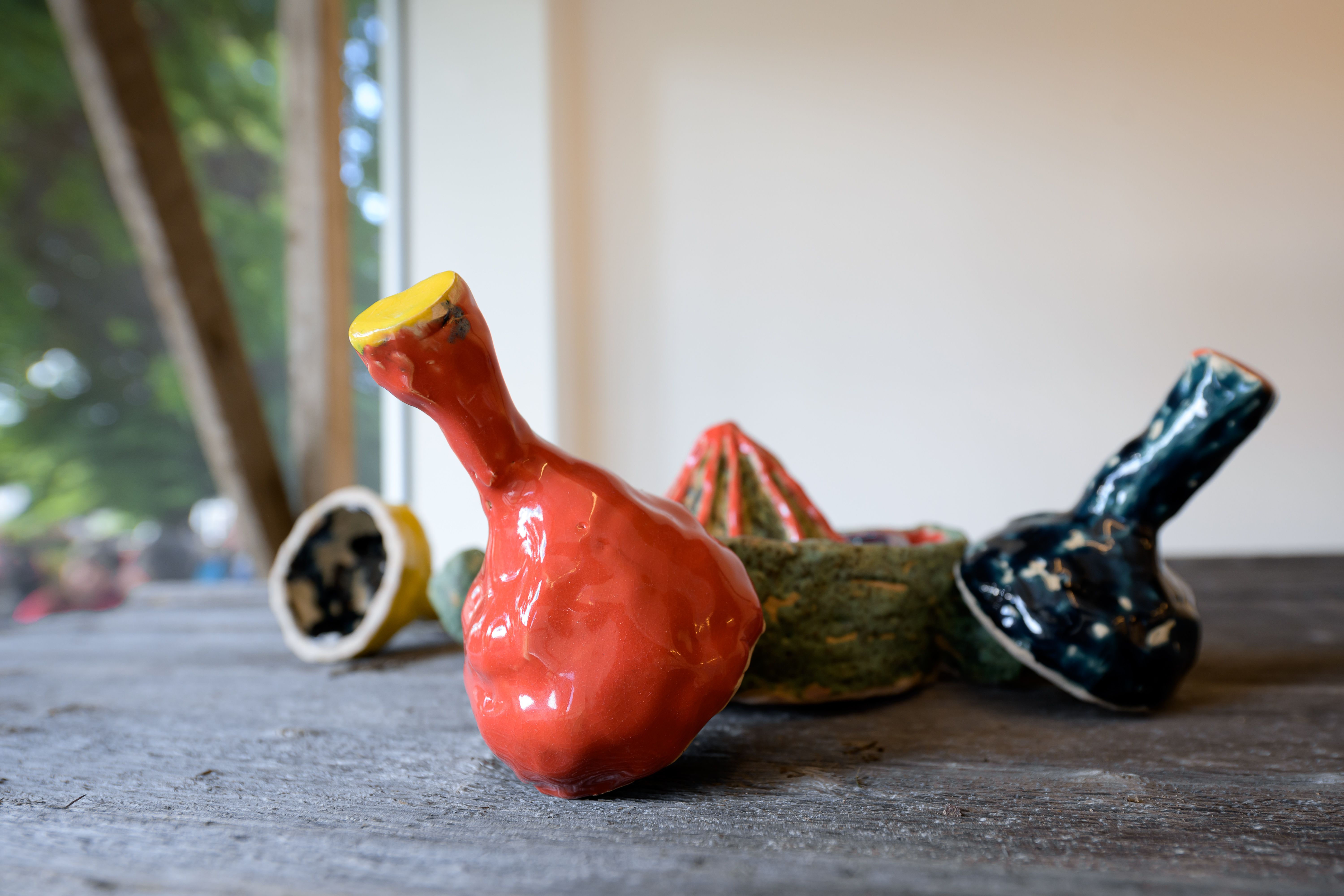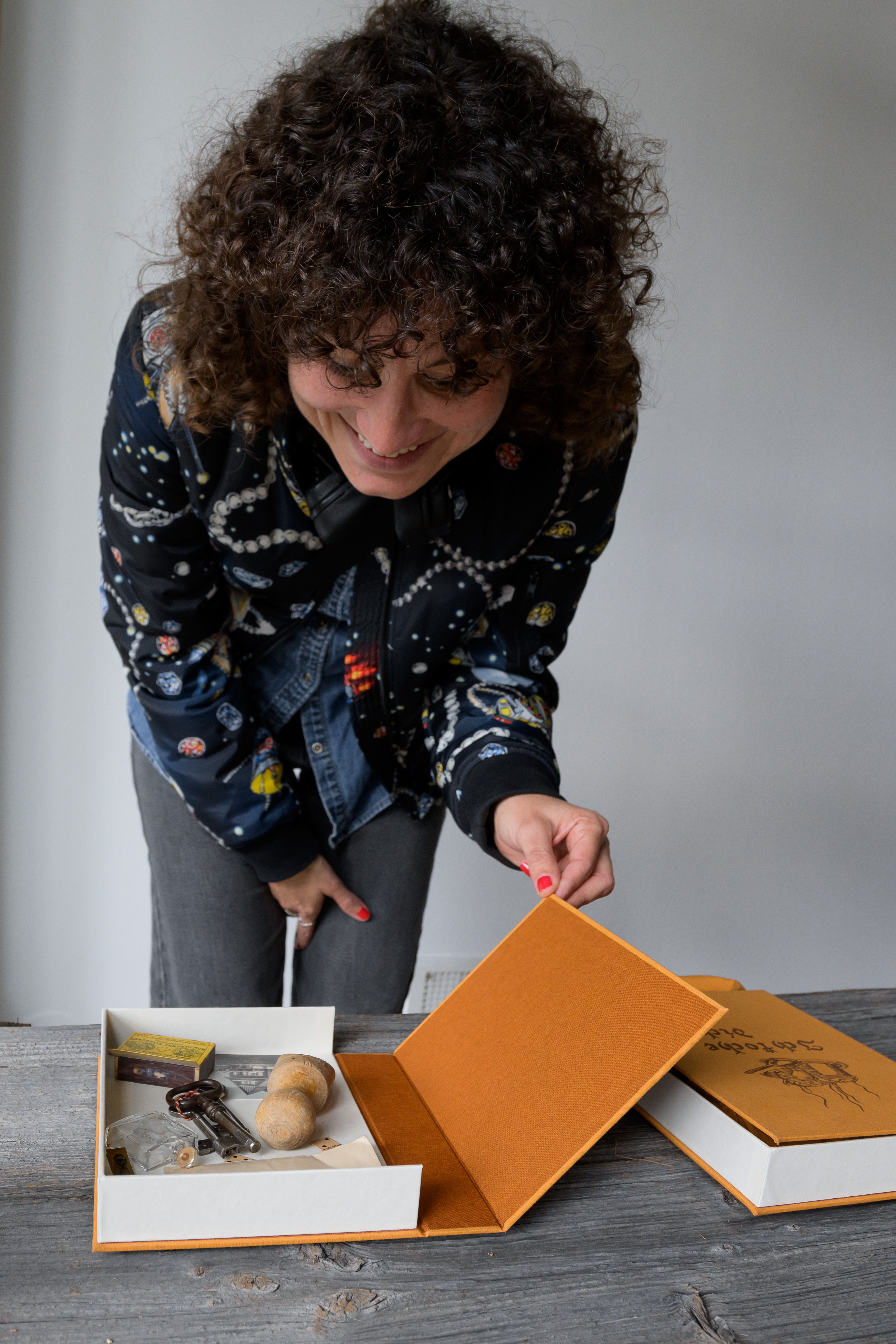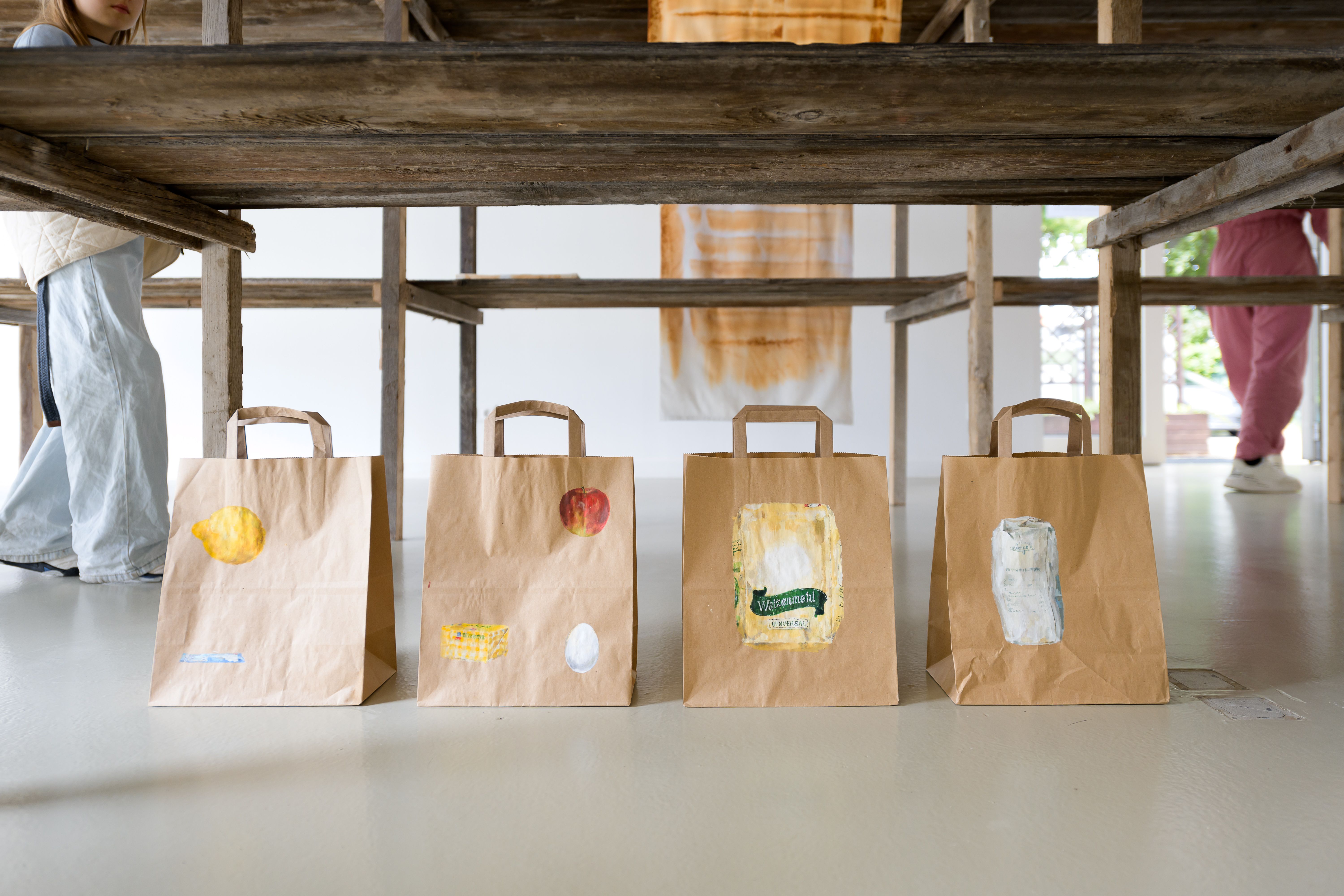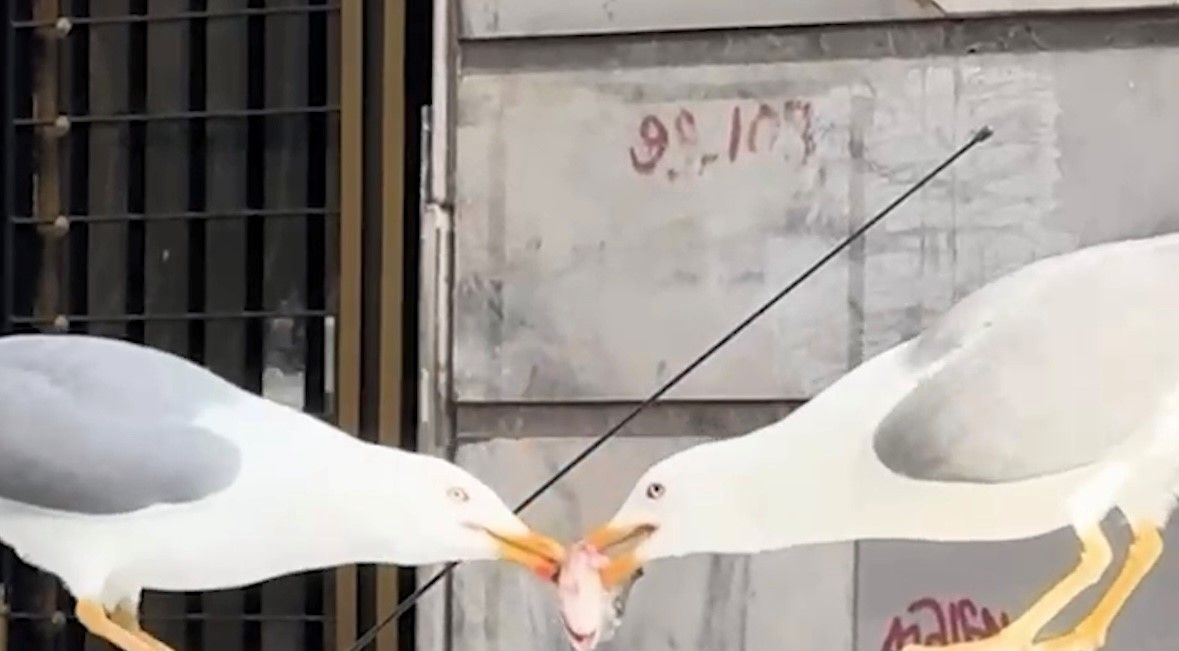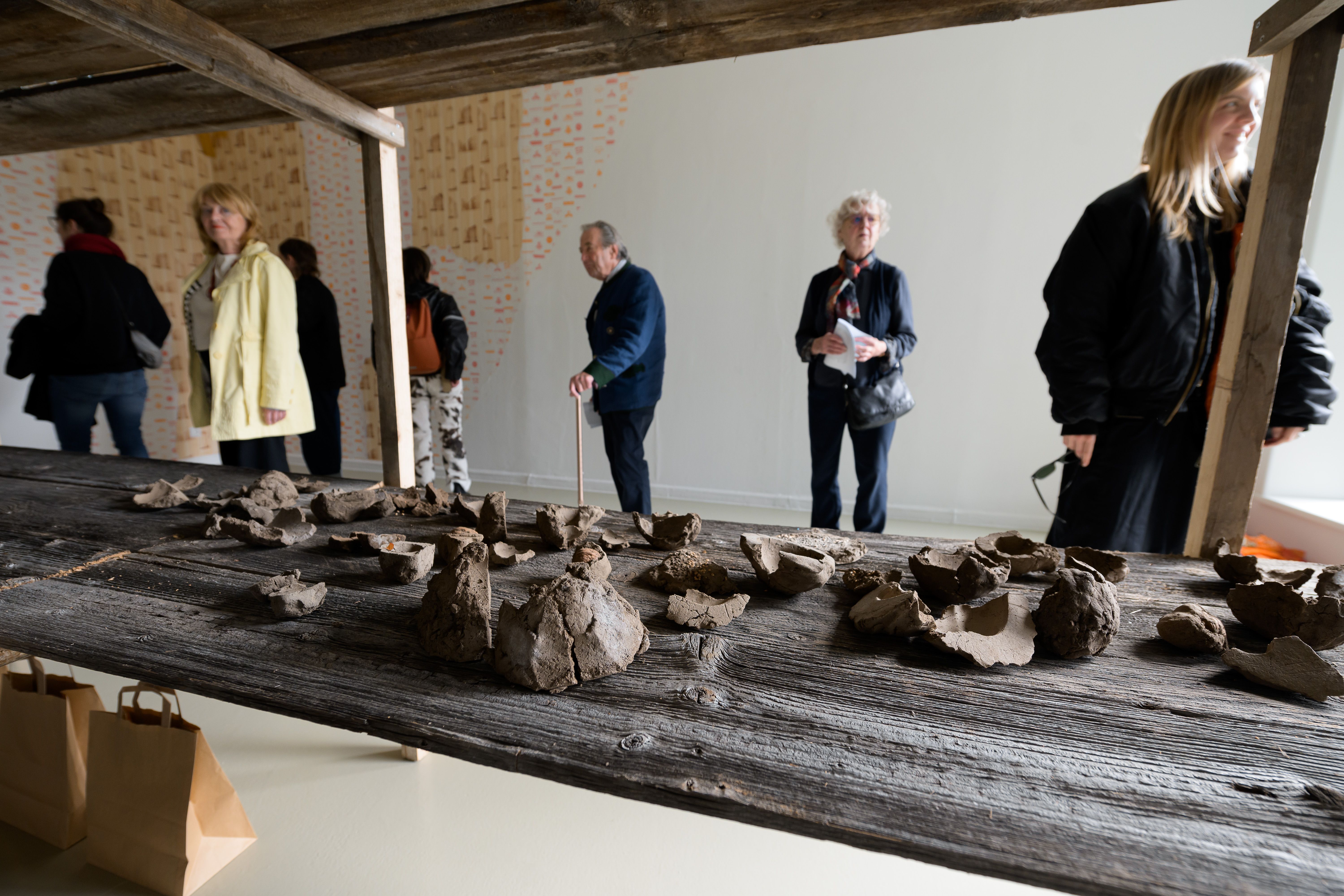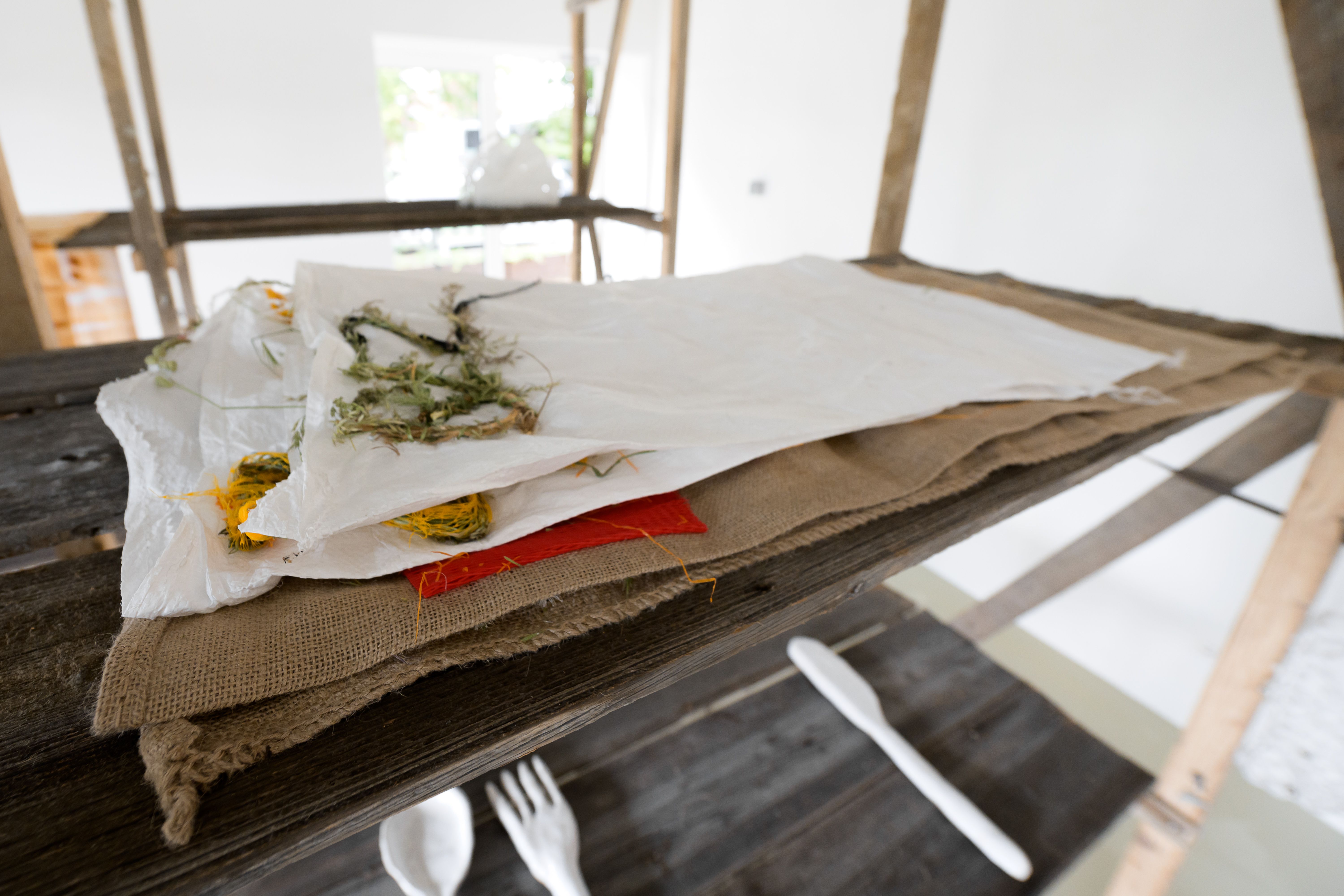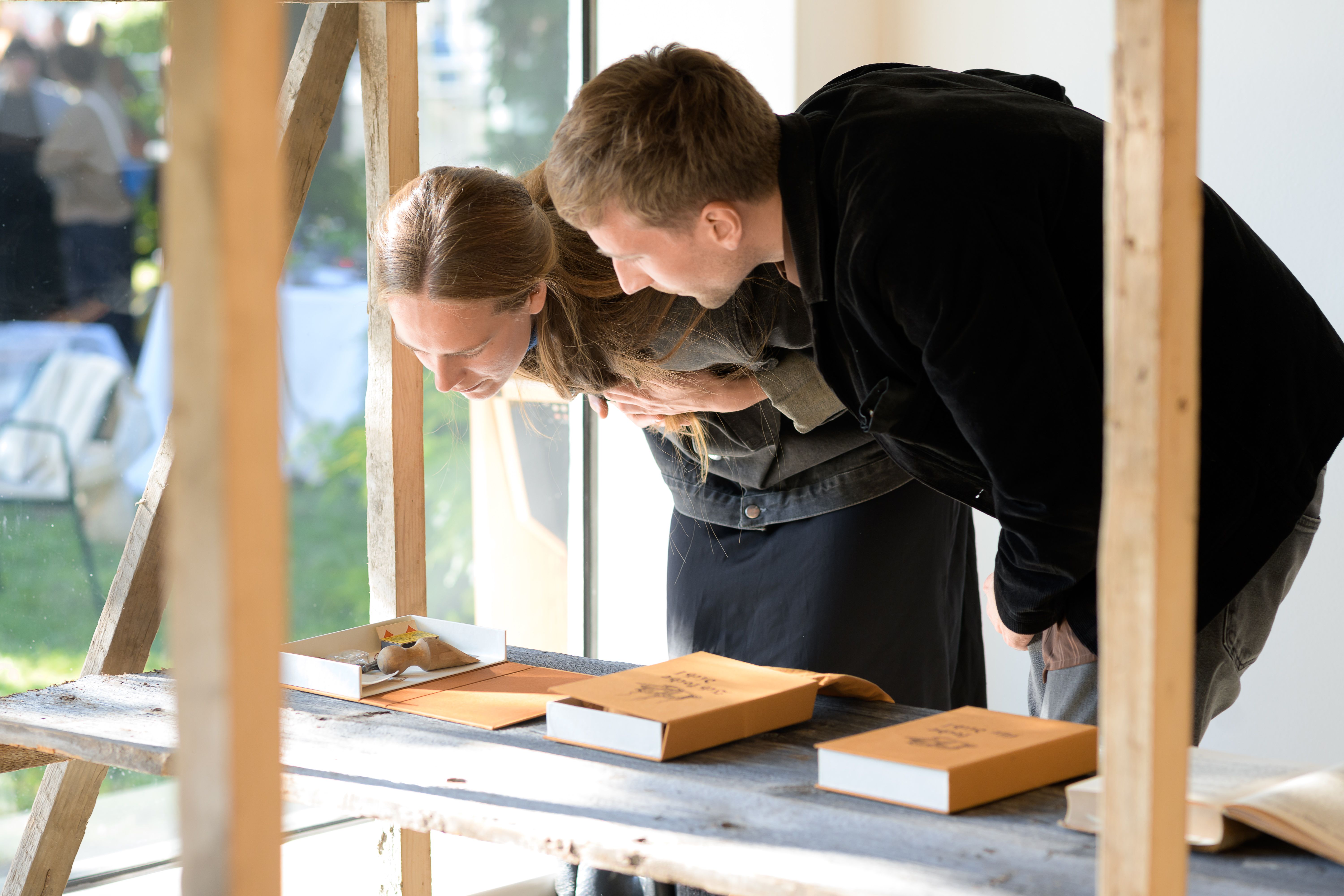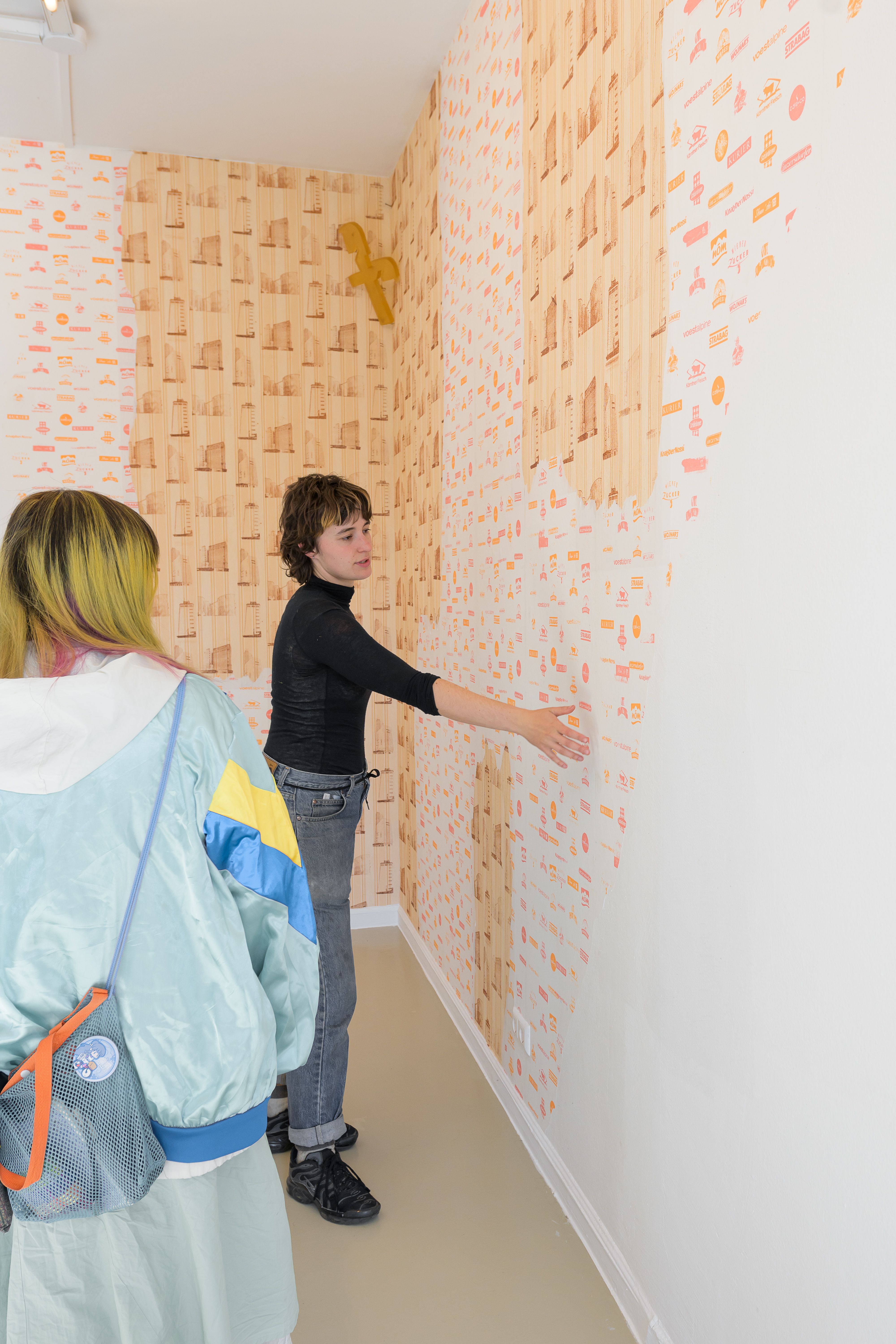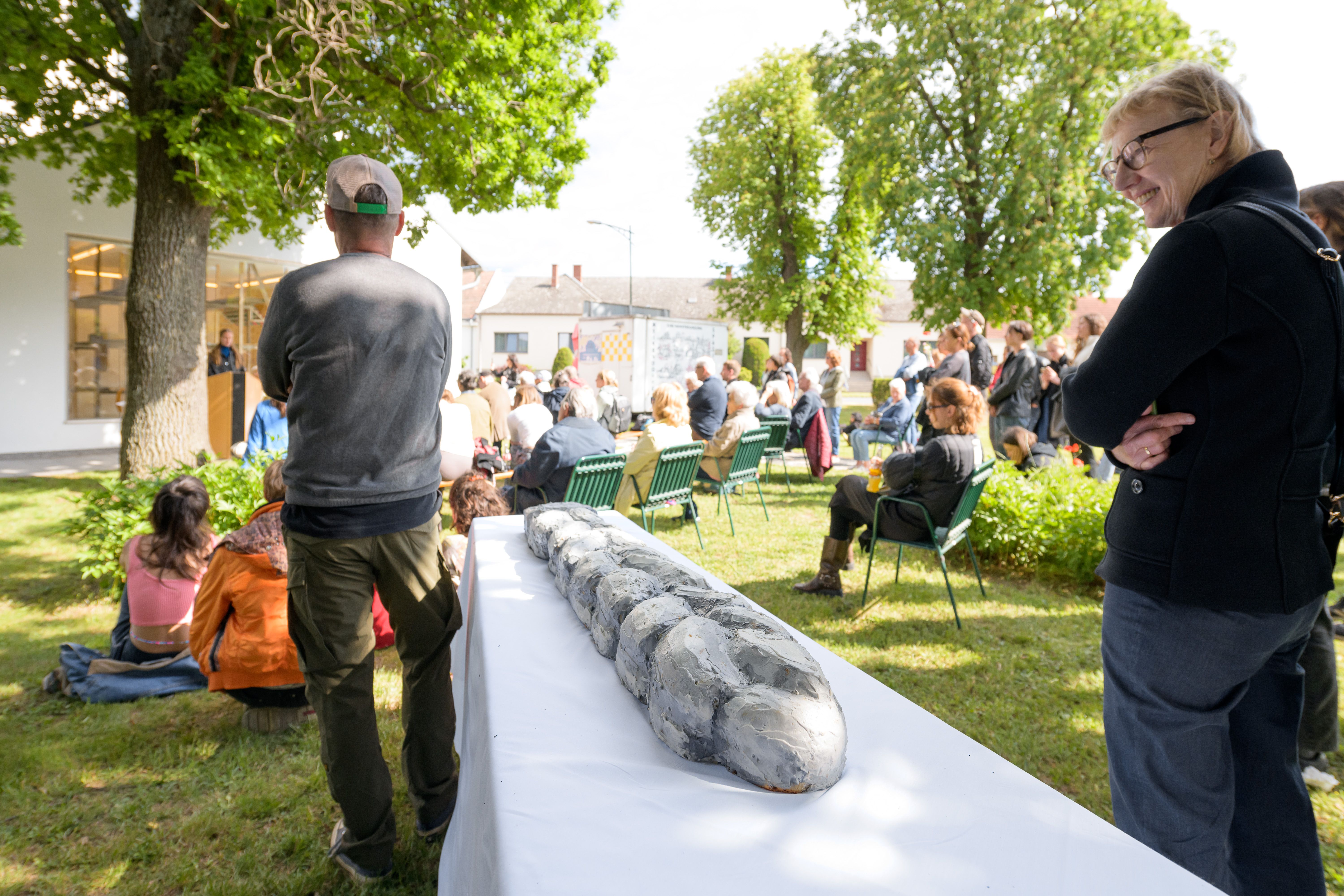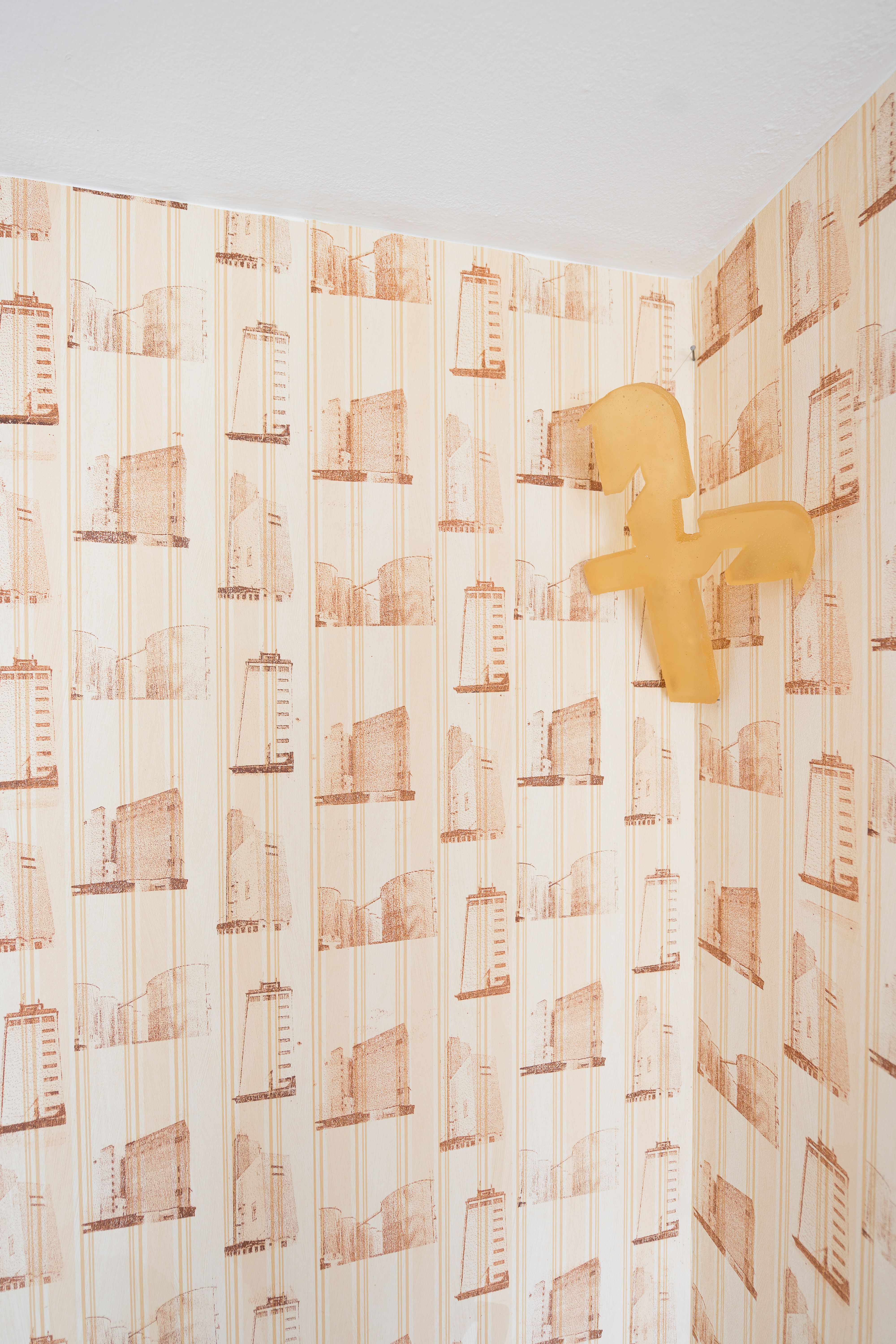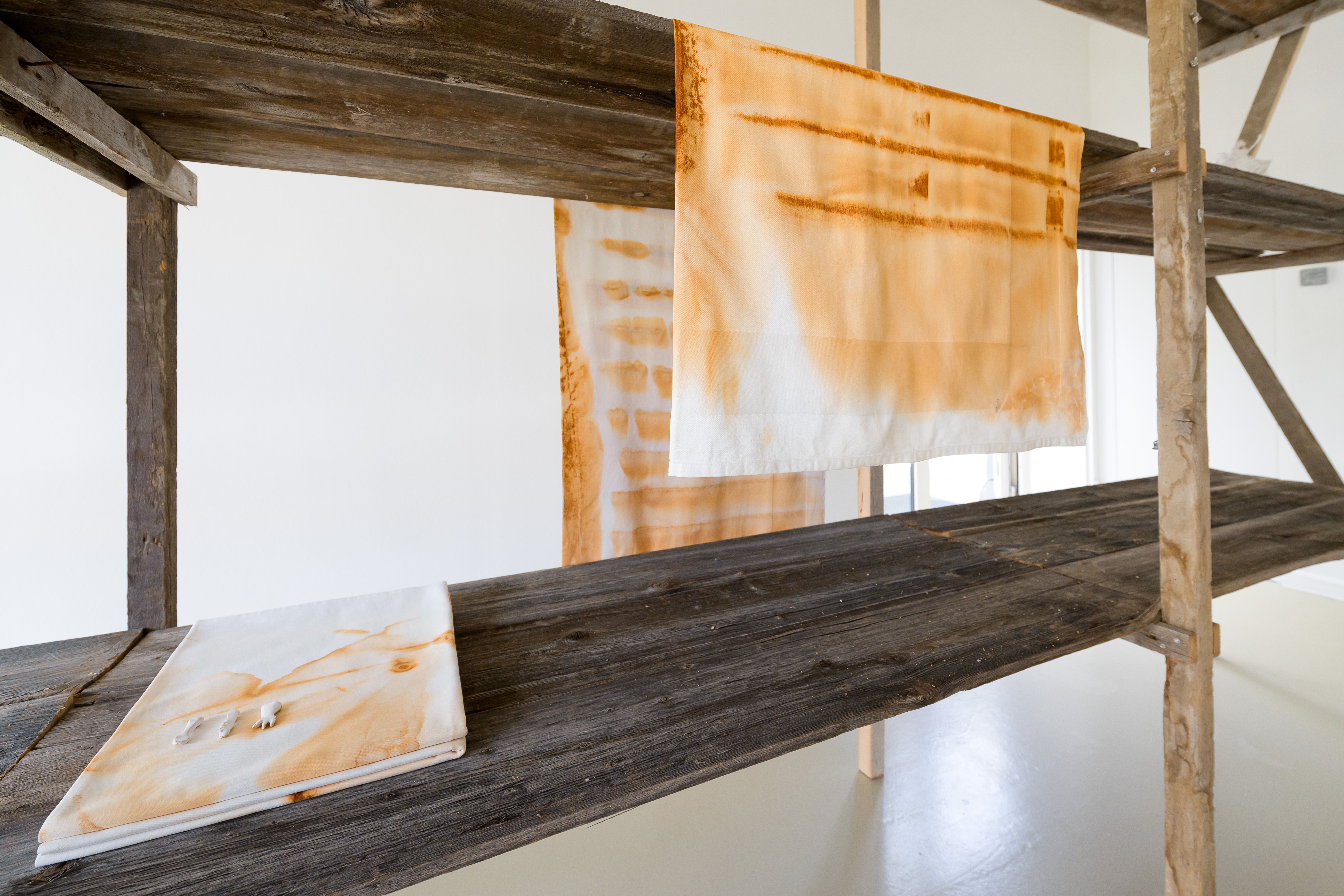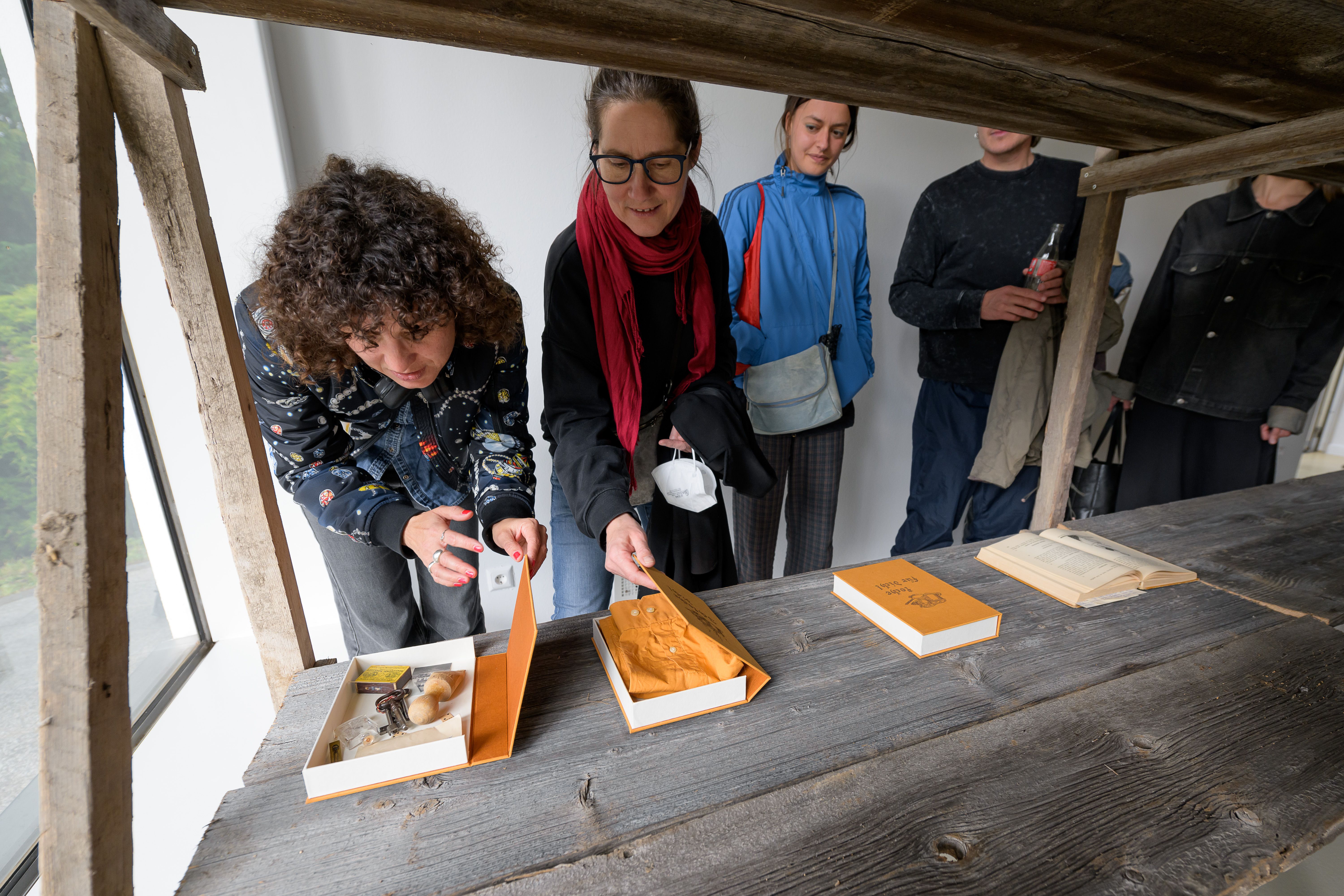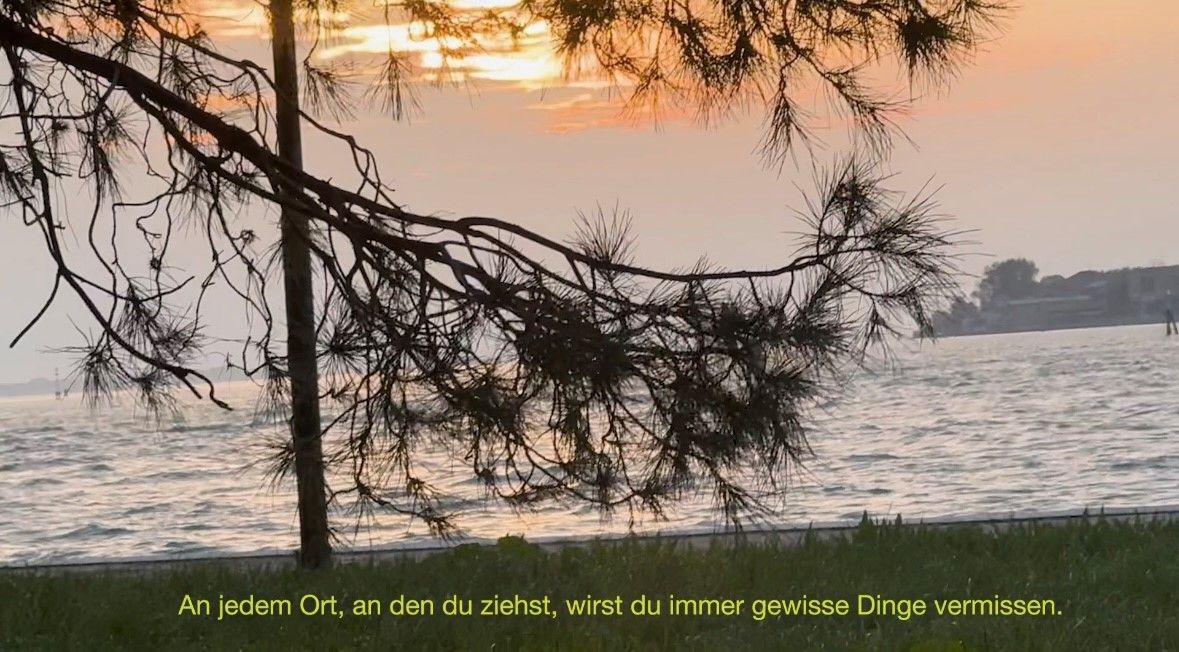Zwischen den Regalen & what we can't contain
BackArtists
- With
Information
Zwischen den Regalen & what we can’t contain marks the culmination of an eight-month artistic research project in Weikendorf, carried out by twelve students from the department for Site-Specific Art as part of the course “Thinking with and learning from Weikendorf I+II,” led by Katrin Hornek at the University of Applied Arts Vienna. The exhibition explores what it means to work site-specifically, engaging not only with the Kunstraum and the landscapes and architectures that characterize Weikendorf, but also with the histories told by its residents or those materially embedded in found objects.
Early in the process, the students focused on Weikendorf’s location in the Marchfeld, one of Austria’s foremost agricultural regions that is often referred to as the Korn- und Gemüsekammer (grain and vegetable pantry) of the country. The pantry, as both a conceptual and formal device, became a starting point for a collective inquiry into food and the broader practices of its production, preservation, and distribution. Within the Abteilung für ortsbezogene Kunst (Department of Site-Specific Art), the ritual of cooking and eating together before weekly class meetings plays a central role in cultivating a sense of community. Through this shared lens, the students developed a series of individual projects that respond to diverse local references: a collapsed barn, a local monument, a found book, disused agricultural tools, closed grain silos, soil samples, and conversations with residents and seasonal workers. The works gathered in the exhibition explore themes of containing and conserving, and interrogate how we preserve both food and shared histories. They invite the public to reflect on the historical transformations and present realities of household labor and work in the field.
The collectively conceived centerpiece of the exhibition, Zwei Regale (Two Shelves), is as much a display for the individual projects as it is a sculpture in its own right, blurring the distinction between display and displayed, between container and contained. The shelves were constructed from wood salvaged from the former Böhm family barn, which collapsed after absorbing too much water during the heavy rains in the fall of 2024. At that time, the barn had already become obsolete and been replaced by a newer barn built to accommodate larger, industrial agricultural machinery. The weathered wood, adorned with occasional marks carved by past agricultural workers, offers a material testimony to local history. The size of the shelves, in turn, reflects multiple shifts of scale in our relation to food—from the household pantry to the industrial storage warehouse, from local to global supply chains. The exhibition reimagines the pantry not as a private, enclosed space, but as a container for community: a place for encounters, discussions, and shared reflection.
The pantry will also be activated during the exhibition. On June 13, the students will host an “Inventour,” a collective herb- and nut-gathering event near the nature reserve Weikendorfer Remise to produce local liqueurs and herbal teas. The filled containers will mature over the course of the exhibition, and their contents can be tasted at the exhibition’s closing.
Johanna Thorell
Contributions
Lisa Reiter
untitled (fridge magnets)
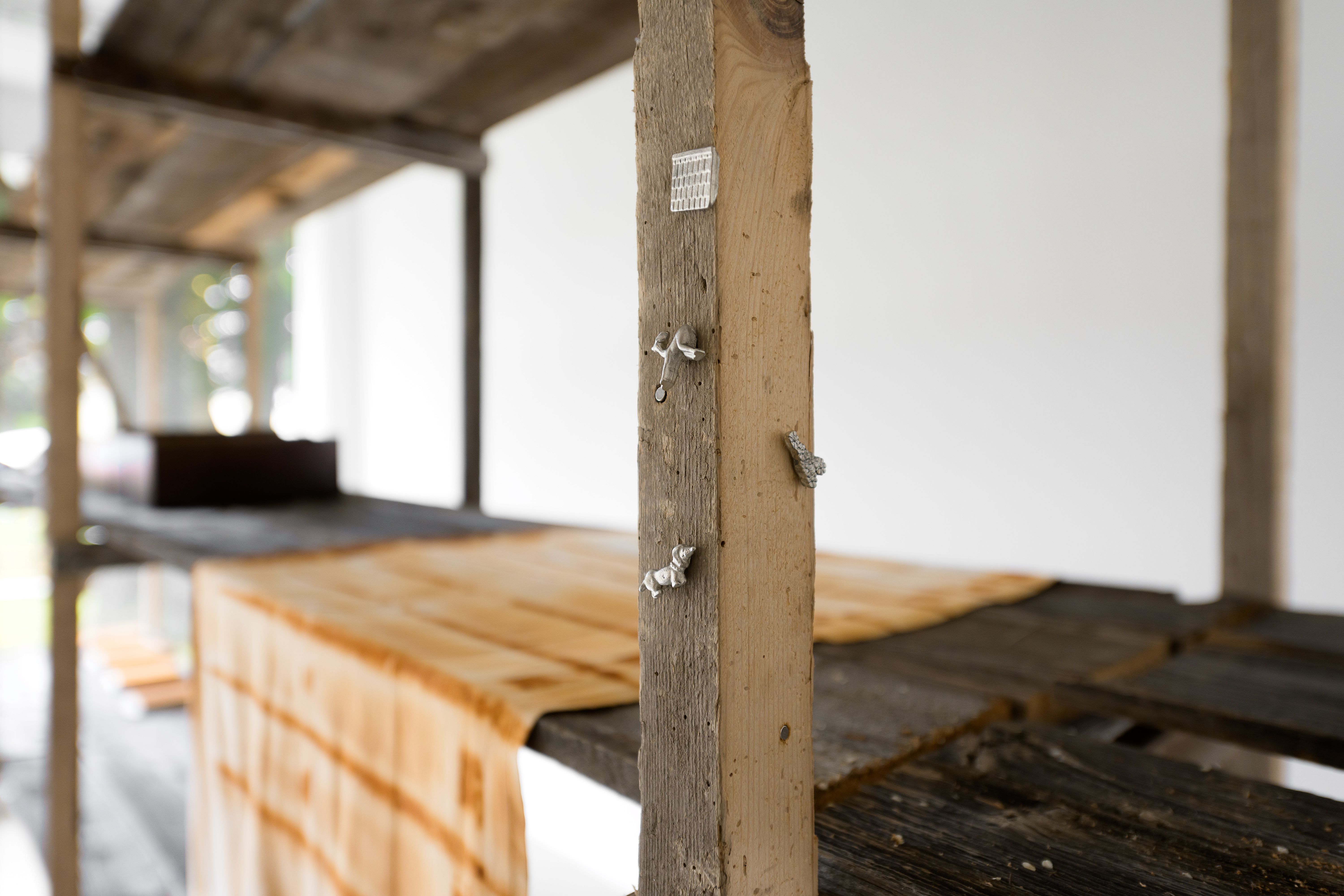
Scattered across the two shelves of the exhibition are Lisa Reiter’s untitled (fridge magnets): tiny sculptures cast in tin, each modeled after plastic figurines once found in Kinder Überraschungsei (surprise eggs) from the artist’s own childhood collection. These seemingly innocent toys—with an iconography that evokes a suburban life and idyll—are among the first objects many children begin to collect, marking an early exercise in building one’s own miniature world. By recasting the figurines in metal, Reiter elevates everyday banality to the realm of art, using the fridge magnet as a lens to reflect on both the accessibility of art and the phenomenon of collecting mania. As a modern-day successor to the pantry, the fridge becomes a site of display, a place where souvenirs and personal items accumulate and can be curated into different constellations. The fridge magnet, which Reiter describes as “comfortably kitsch,” prompts us to consider our own rituals of collecting, and how the objects we gather shape our sense of home and aesthetic value.
Viktoria Hilbert
Bez brigádnikov zostáva špajza prázdna / Ohne Gastarbeiter*innen bleibt die Speis leer (conceived with Jayda Sauseng and done in collaboration with Sezoneri)
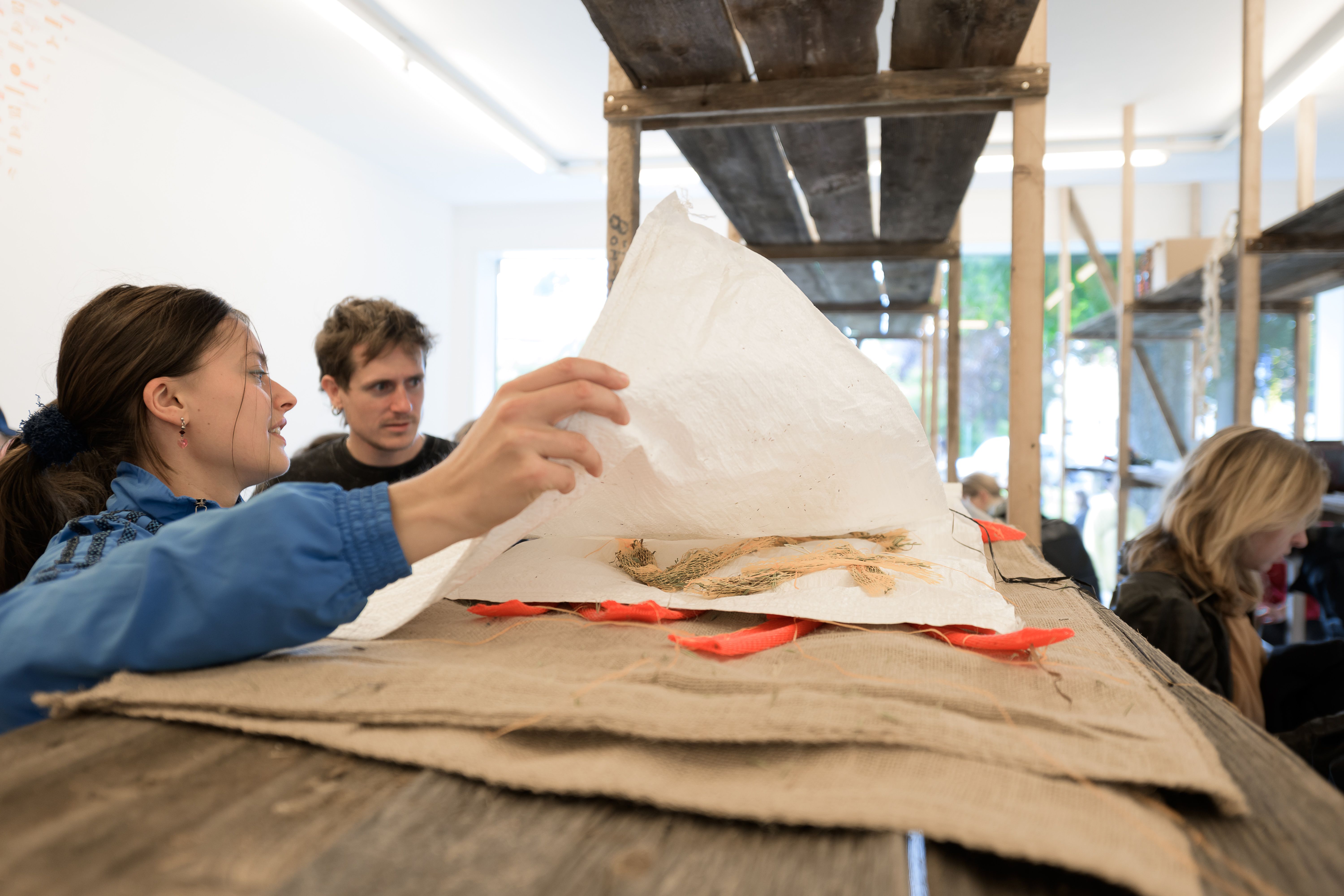
Conceived with activist and social worker Jayda Sauseng, and done in collaboration with Sezonieri—an initiative advocating for the rights of migrant harvest workers in Austria—Viktoria Hilbert’s performance draws attention to the often-invisible labor of seasonal workers who sustain the agricultural production in the Marchfeld region. Over the course of the exhibition, Hilbert will perform a 12 to 16-hour shift at Kunstraum Weikendorf on three occasions, thus mirroring the length of the physically demanding workday of many seasonal laborers. During each shift, the artist will work on a textile piece using agricultural materials. By embroidering on coarse jute sacks, typically used for storing the harvested crops, she transforms the functional and unglamorous fabric into a site of quiet yet manifest resistance. Stitched in Slovak, a language spoken by many seasonal workers but largely illegible to most Austrians, the embroidered phrases become gestures of recognition, solidarity, and visibility. Through this act, Hilbert transforms a container of food into a sign of recognition that honors both past and present seasonal workers, whose labor is still often overlooked in the dominant narratives of agricultural prosperity.
Yevheniia Pavlova
The Memory of Earth
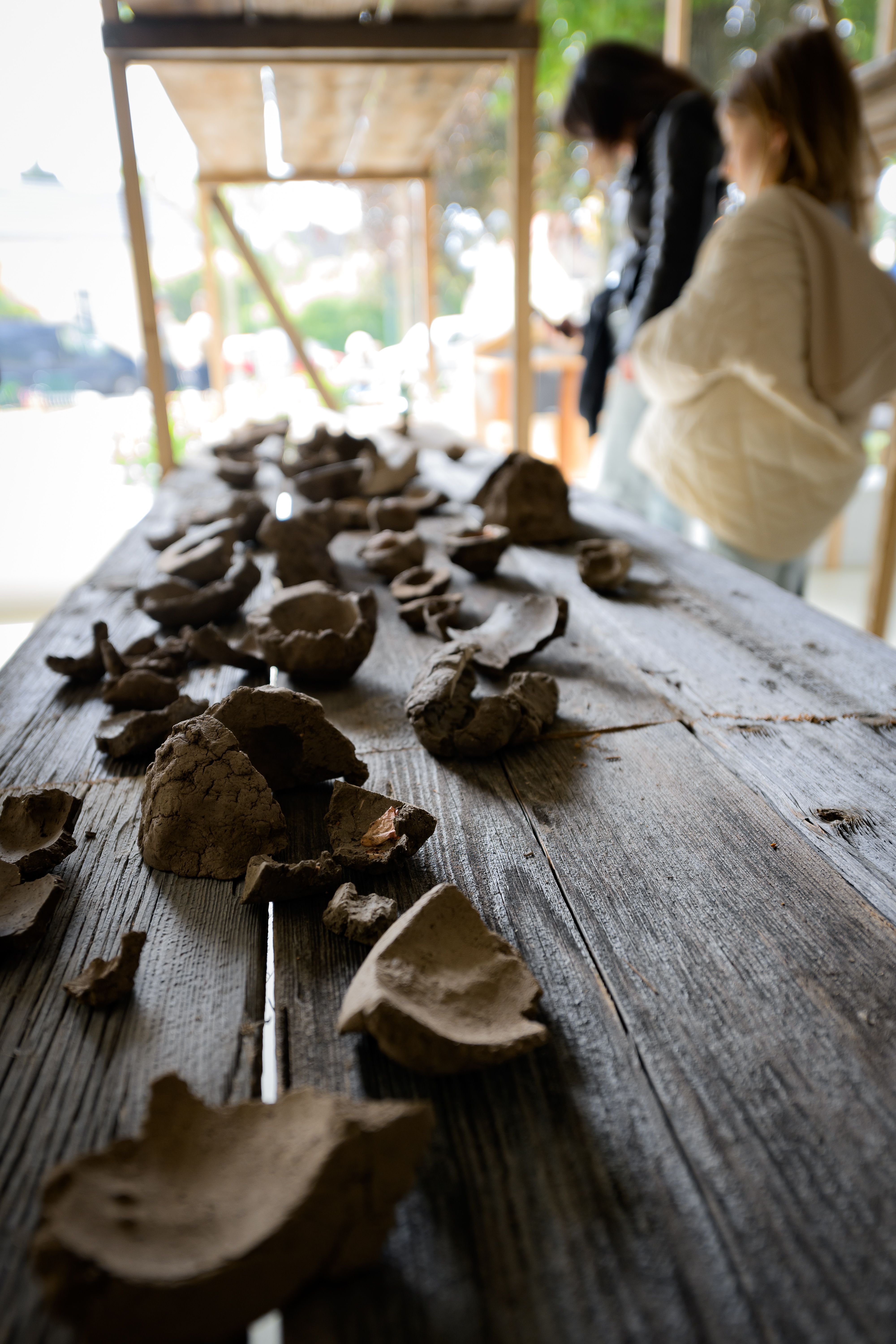
Yevheniia Pavlova’s The Memory of Earth reflects on histories of repression and resistance through the lens of soil and starvation as a weapon of war. Crafted from the dark and nutrient-rich earth of the Marchfeld region, the shell-like forms carry the imprints of the fruits, vegetables, grains, and nuts they once enveloped. The material of the sculptures visually echoes Ukraine’s chernozem, the so-called “black earth” that has long symbolized agricultural abundance. Yet, beneath this fertile soil lies a painful history: During the Soviet-orchestrated famine of 1932–33, known as the Holodomor, food was deliberately withheld to suppress local resistance to the forced collectivization of agriculture. In response, Ukrainian peasants buried their harvest and other food underground in an act of defiance against looting and starvation. If the Soviet authorities, who routinely probed the soil for signs of recent digging, discovered a hidden cache of buried food, they would confiscate it and, in some cases, arrest or execute the people deemed guilty, leaving behind only emptiness. Pavlova references this burying through the negative spaces in her sculptures, which evoke hidden or removed food in a haunting presence through absence. The earth-formed pieces embody the fragility of survival under political repression and speak not only to historical trauma and the current reality of war in Ukraine, but also to a potential resilience inscribed in the land itself. Using local earth provided by Weikendorf farmer Herr Böhm, the delicate sculptures connect two different geographies through a shared soil, exploring the earth’s capacity to hold, to remember, and to testify.
Michelle Schäfer
wir haben aufgegessen
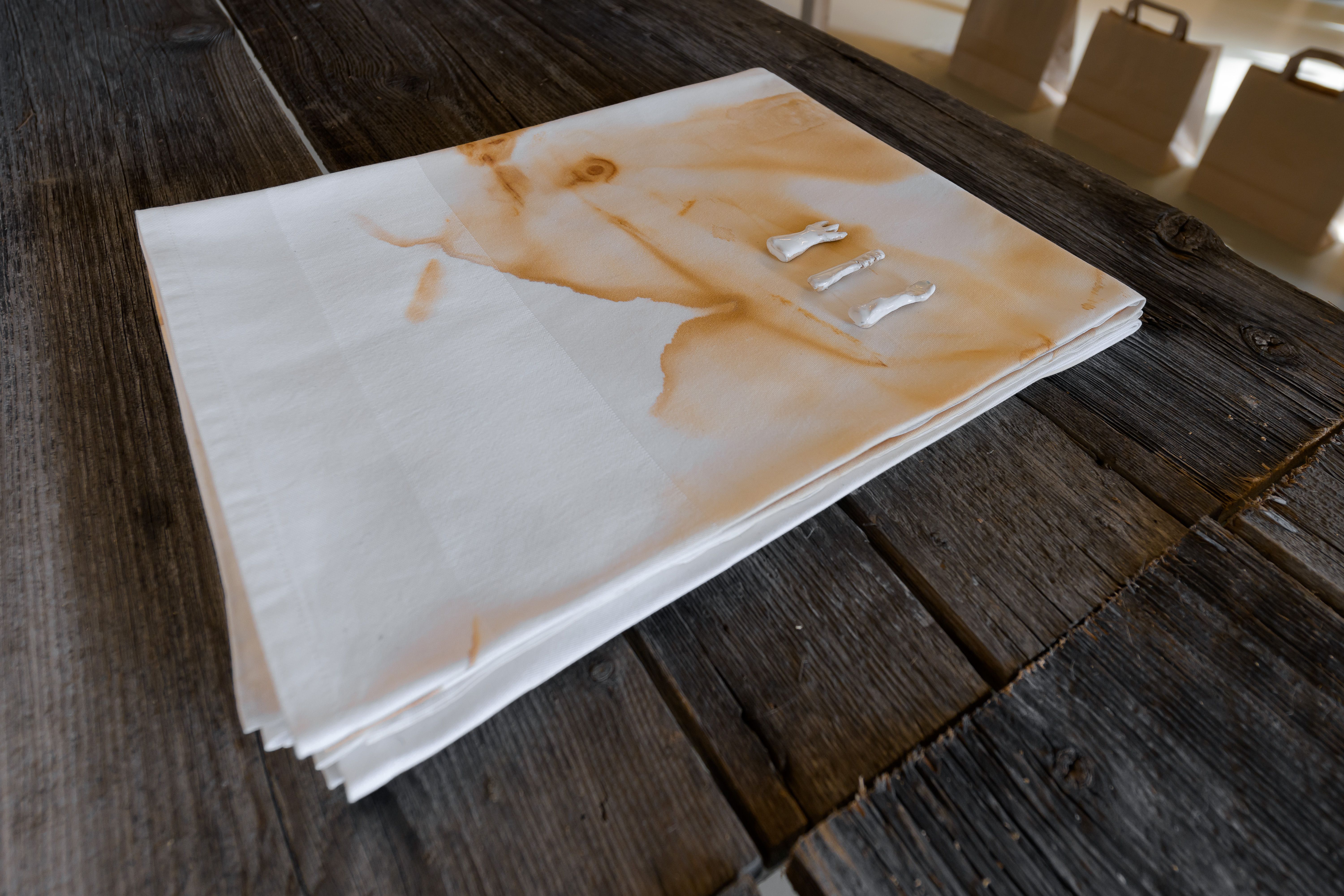
Michelle Schäfer’s wir haben aufgegessen (we ate up) experiments with alternative forms of conservation by capturing impressions of rusty objects on white tablecloths. The objects in question are parts of old agricultural tools and machines, such as a plough found in the collapsed barn of the Böhm family. Schäfer applies vinegar to the rusted metal parts and drapes the tablecloths around them, allowing the oxidation to transfer to and stain the fabric. The resulting rusty red imprints resemble the marks once made on the soil by these very tools, evoking both the physical traces and the spectral presence of disused agricultural tools. Like ghosts of a bygone era, the machines are remnants of the process of industrialization. The old equipment can no longer compete with ever-expanding agricultural fields and massive, GPS-driven machinery. While many of the region’s farmers now manage far larger fields than their parents once did, the number of people working in the fields is becoming increasingly scarce. Much like a tablecloth retains the stubborn stains of shared meals, Schäfer’s rust prints forever preserve the memory of these tools.
Laura Ana Josic
mundgerecht (bite-sized)/ zitronen pressen (squeezing lemons)
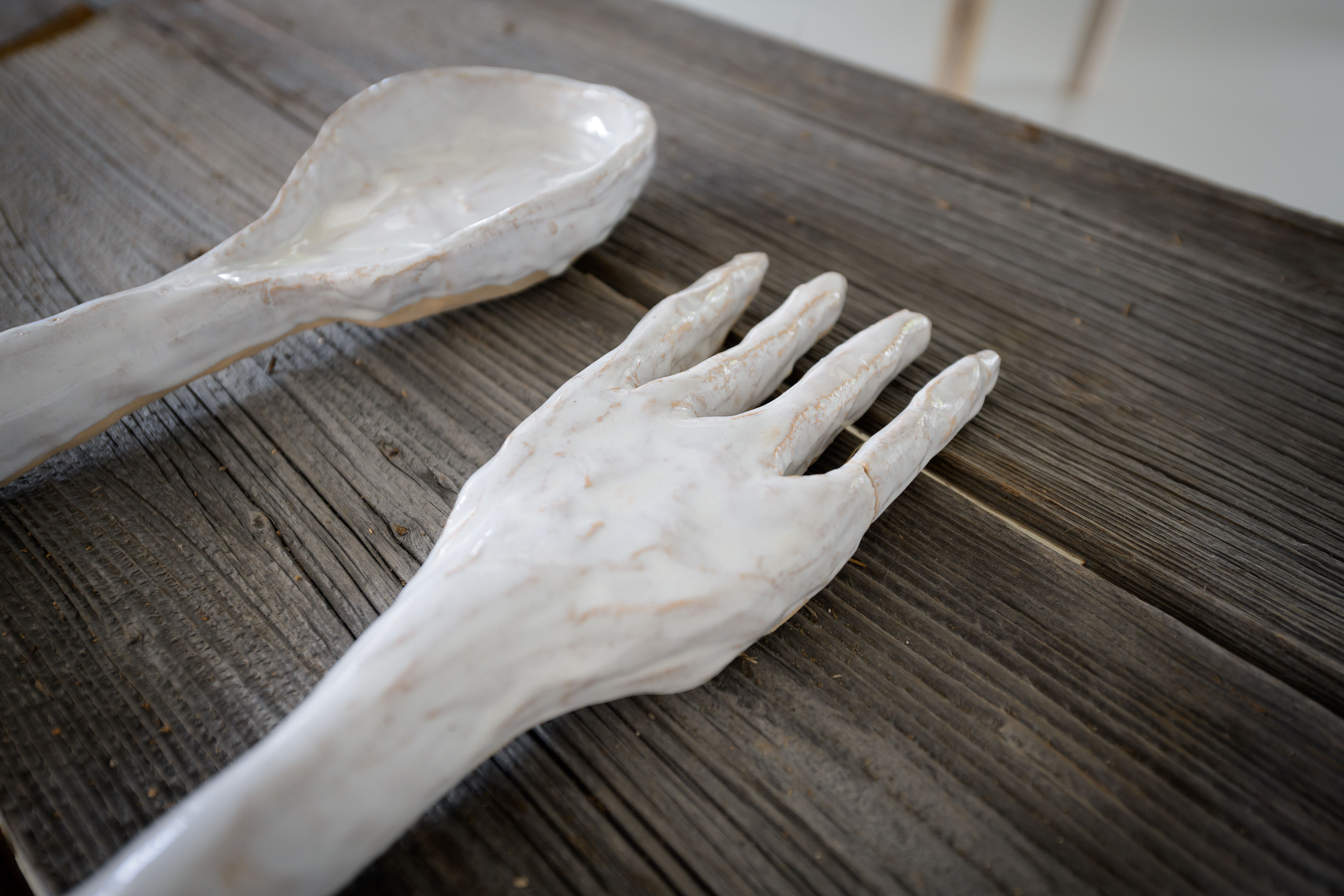
Not unlike the two shelves that have been enlarged to resemble industrial shelving systems, Laura Ana Josic’s cutlery pieces play with extremes of scale, transforming everyday utensils into both delicate miniatures and monumental forms. Rendered in white glazed ceramic, the miniature fork, knife, and spoon play with our perception of everyday objects. mundgerecht—meaning “bite-sized”—whimsically hints at the literal scale of these utensils, which are small enough to fit in the mouth. Meanwhile, the oversized fork and spoon resemble a hay fork and a shovel. Like in a cinematic zoom isolating details we typically overlook, Josic’s sculptures magnify the otherwise unnoticed forms of some of our most familiar tools. Cutlery, among the most commonly used instruments of daily life, becomes absurd, strange, and sculptural. In another work titled zitronen pressen, exhibition visitors can contemplate the formal qualities of a citrus juicer removed from its context of use. Forms that are passed over, unnoticed in their mundanity and functionality, become sculptures in their own right.

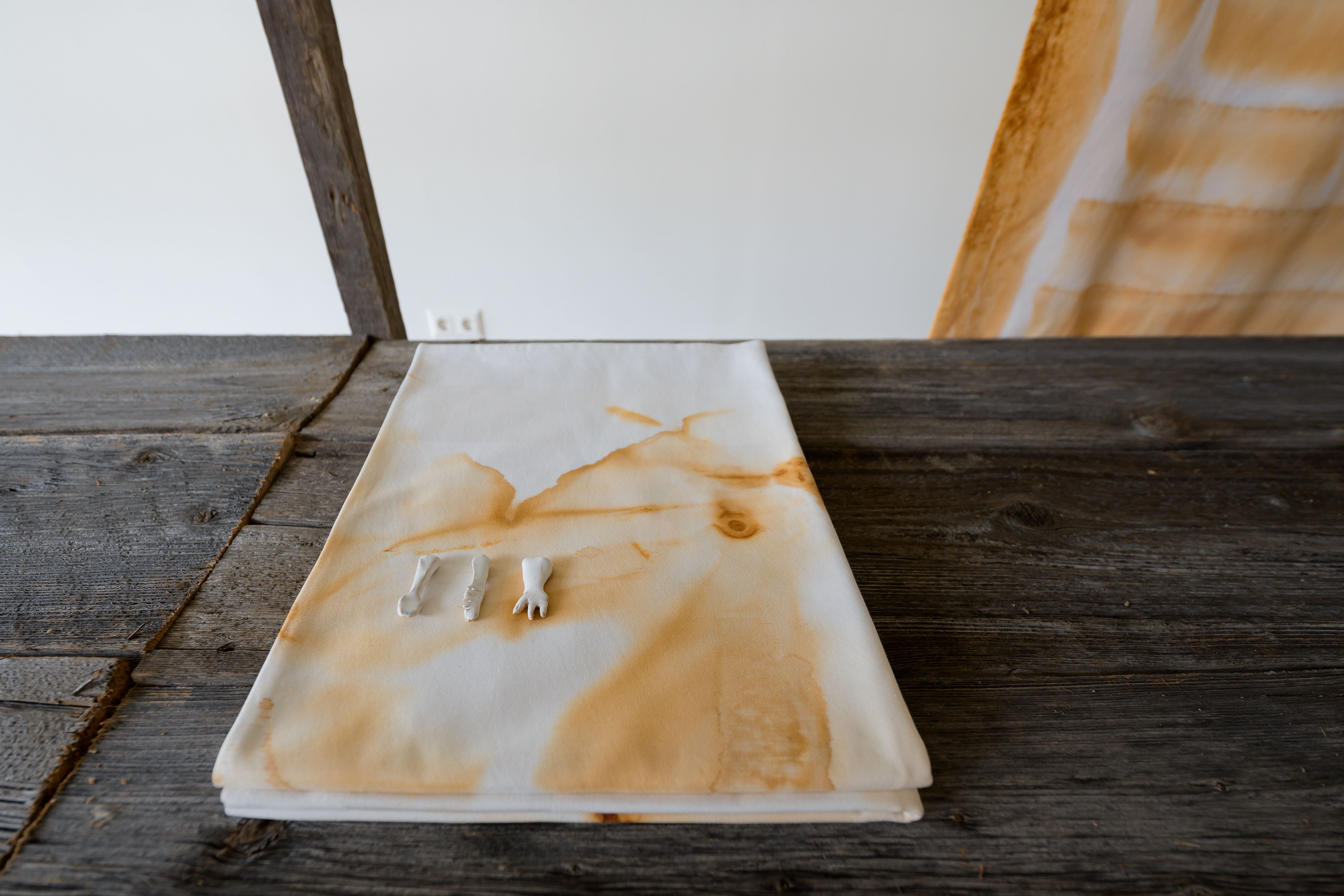
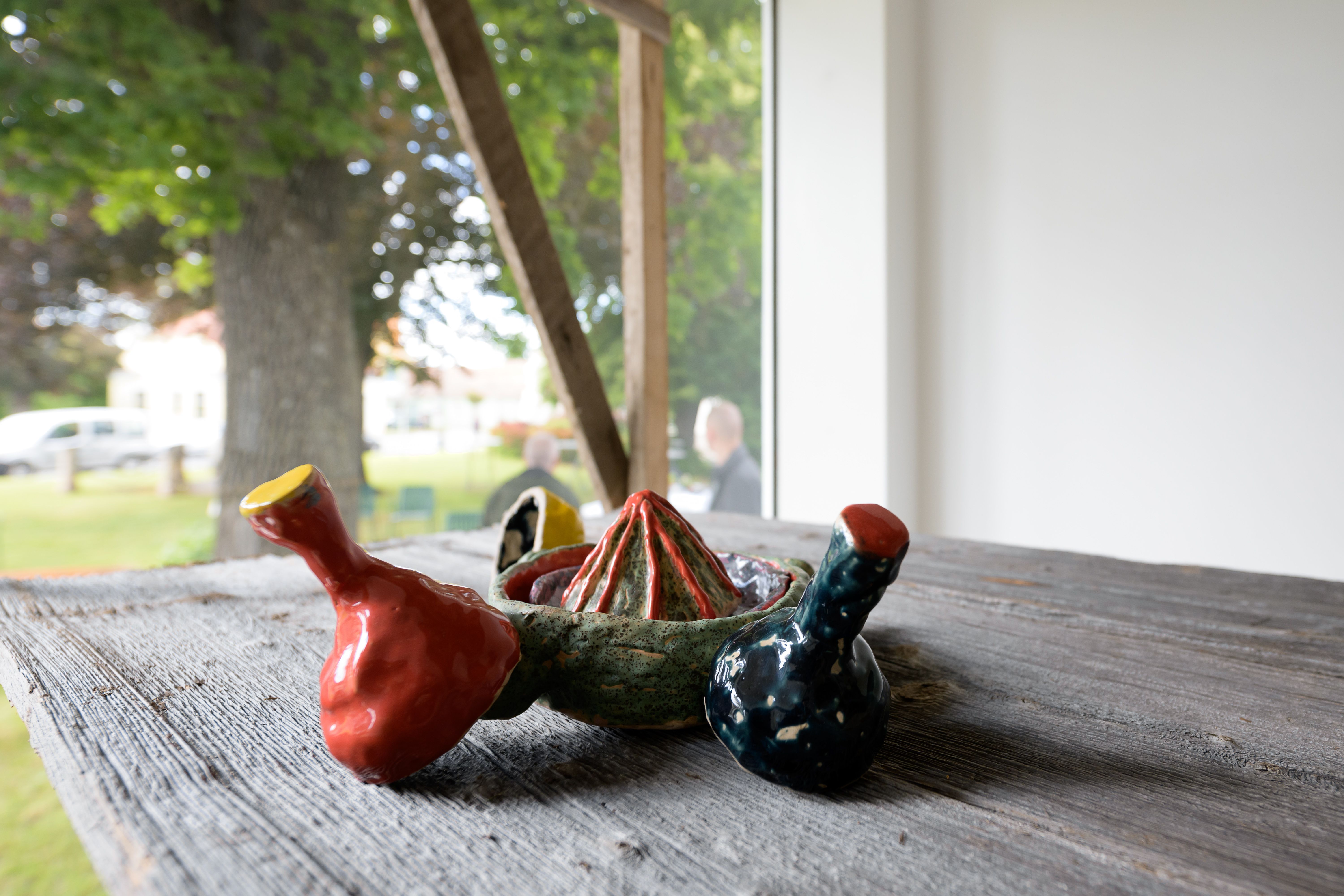
David Carol Fedders
All those colors to my dreams

Delicately placed atop the shelves is a small roof made of colorful tiles cast in sugar. Molded after the tiles of the Böhm family’s collapsed barn, David Carol Fedders’s All those colors to my dreams reimagines a protective structure in a material that dissolves in water. The result is a paradoxical object that is visually suggestive of shelter, yet so structurally fragile that it becomes unusable. This artistic intervention merges the memory of a specific architectural element with a transformable material, turning a once-solid roof into a dreamlike, dissolvable fragment.
Flores Paul
(Ich) koche (für) (dich)! (I cook for you!)
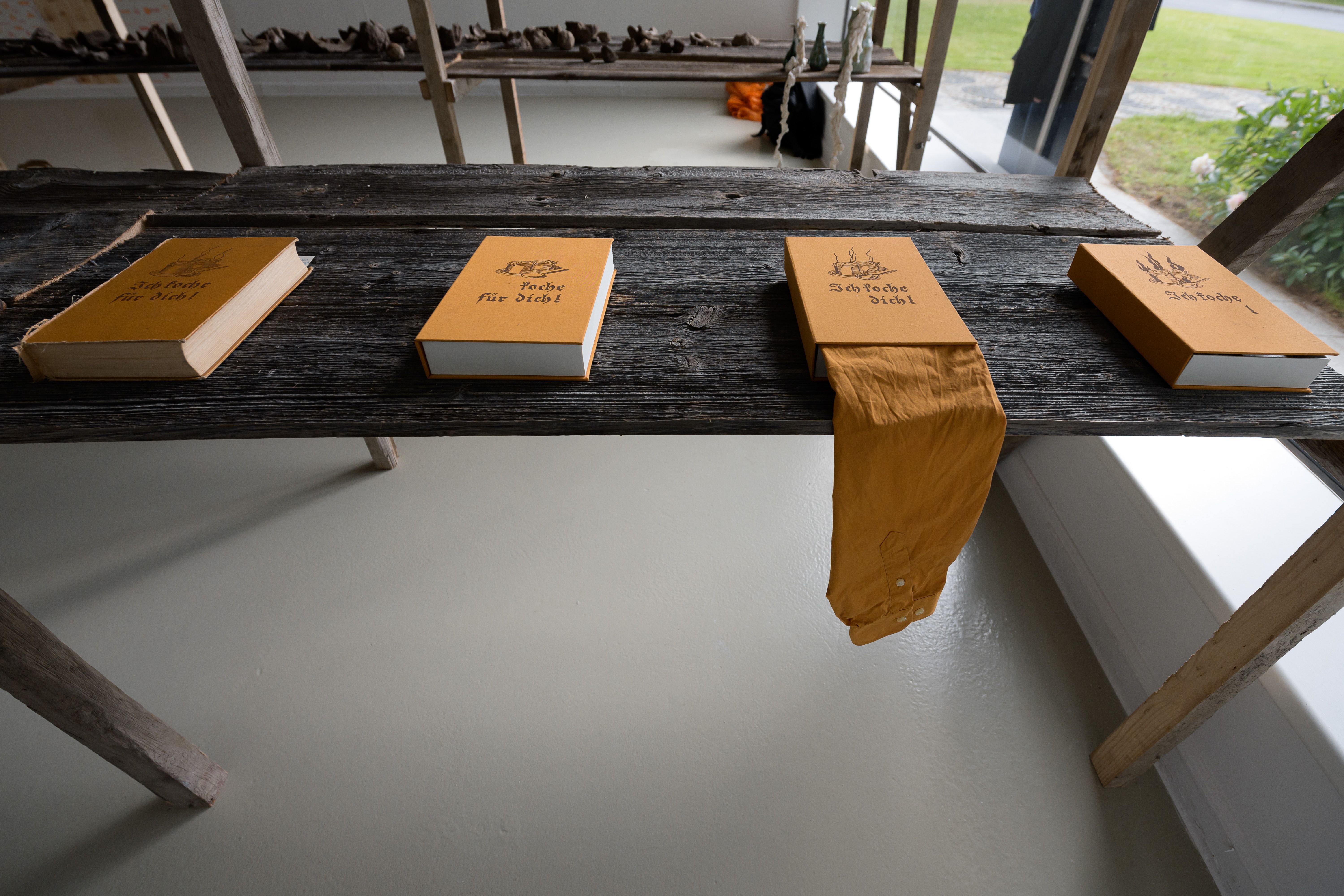
Flores Paul’s work, a found book and a series of three book-like objects with carefully crafted covers, takes as its starting point a cookbook from 1935 titled Ich koche für dich! [I Cook for You!], which she discovered in a local book exchange housed in a former telephone booth in Weikendorf. Far from being merely a collection of recipes and household advice, the book serves as a historical document outlining the responsibilities and expected conduct of a good housewife. Its author, Ruth von Schüching (née Goetz), was a prolific writer engaged with questions of women’s emancipation until the Nazi regime banned her from publishing due to her Jewish descent. Alongside the discovery of Schüching’s cookbook, the artist spent time with members of the two local clubs for seniors and pensioners, engaging in conversations about gendered divisions of household labor. Paul observed that many women had few opportunities to participate in public and social life, because they remained confined to their domestic responsibilities. These oral histories, together with the cookbook, form the foundation of a critical reflection on both historical and contemporary gender roles. Who used the pantry, and who still bears the burden of care and social reproduction today? Through subtle interventions, such as putting words in the book’s title in parentheses and creating “books” that serve as containers for new rules of conduct, Paul proposes acts of domestic disobedience and opens a space where the gendered scripts of household labor can be rewritten.
Tutku Kocabaş
Gurbetcore
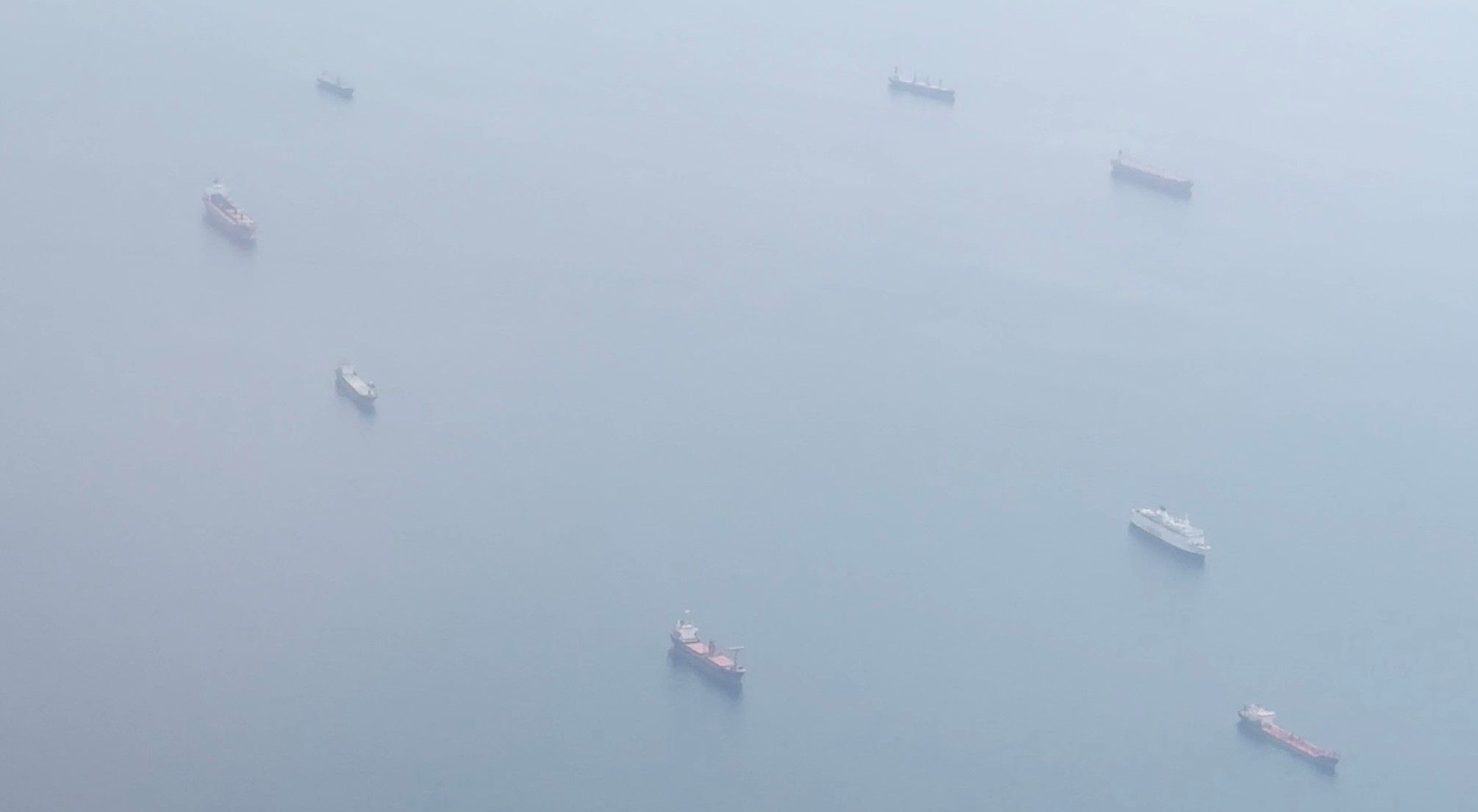
On the backside of the Kunstraum Weikendorf, installed in a local grocery store—a site shaped by the food industry’s constant flow of commodified produce—Tutku Kocabaş’s video quietly meditates on what it means to live far from home, both emotionally and physically. As the camera winds through the city of Istanbul, its restless movement mirrors the experience of spatial displacement. The voiceover, narrated as a note to a past self, conveys the longing of someone looking back from afar. The artist calls this feeling Gurbetcore, a term of her own invention that fuses gurbet, a Turkish word describing the deep ache of being far from home, with “core,” suggesting a quiet strength shaped by distance. The work captures not only the pain of homesickness, but also the resilience required to carry on in an unfamiliar place. By placing this personal testimony in a grocery store—a functional, semi-public space where everything and everyone is in transit—the feeling of displacement is embedded in objects in constant motion. An irreducible, enduring emotion seeks a temporary anchor alongside goods that are briefly displayed before continuing on their journey.
Lena Heinschink
Voraussetzungen (mothers and others who hold)/ in tränen ausbrechen (burst into tears)
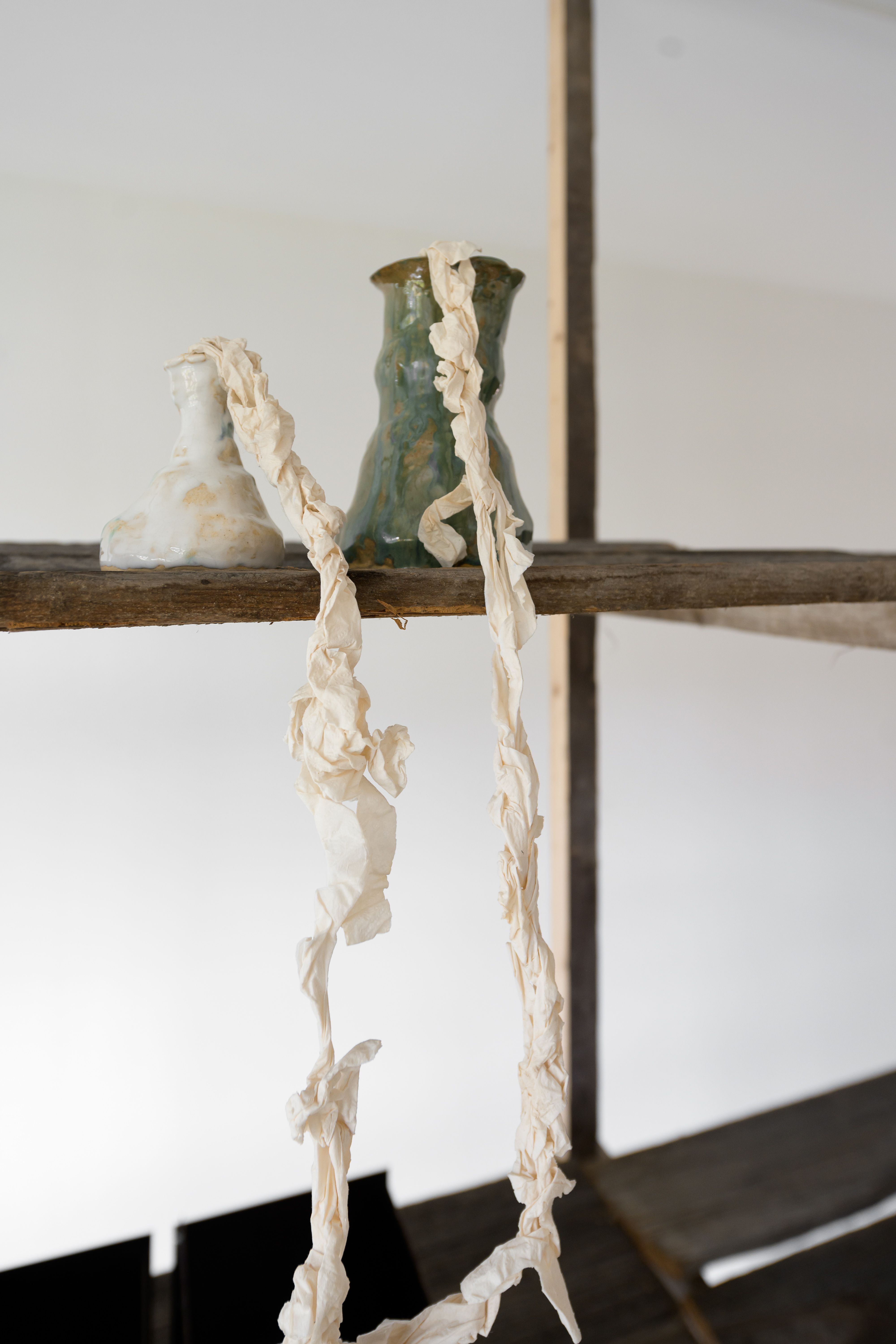
Lena Heinschink’s works explore the poetics of containing through a series of sculptural baskets and ceramic vessels. Her hand-crafted containers combine artisanal crochet techniques and weaving with industrially manufactured threads, producing oxymoronic objects that invite reflection on the gendered hierarchies of different types of labor and the materials embedded within them. Inspired by Ursula K. Le Guin’s speculation that the first human tools were likely containers rather than weapons—in other words, forms for carrying what had been gathered, rather than spears for hunting—Heinschink reclaims the containers as a cultural invention rooted in care, gathering, and provision. Crafted in various shapes that can hold wild herbs and fruits gathered on the INVENTOUR, the baskets emit a soft chime when they are put in motion, challenging the idea of the container as passive or unobtrusive, as something that merely holds something else, yet itself goes unnoticed. Elsewhere in the exhibition, the vase-shaped sculptures titled in tränen ausbrechen (burst into tears) offer a more fragile image of containing in the form of vessels that leak, overflow, and release. Referencing ancient objects that archaeologists have named lachrymatories, or tear-catchers, these forms evoke bodies unable to hold in their emotions and are thus defined not by what they contain, but by what they cannot. In both works, Heinschink challenges the binary of container and contained, proposing instead a dynamic model of holding: one that includes receiving, preserving, and, ultimately, giving in an act of outpouring.

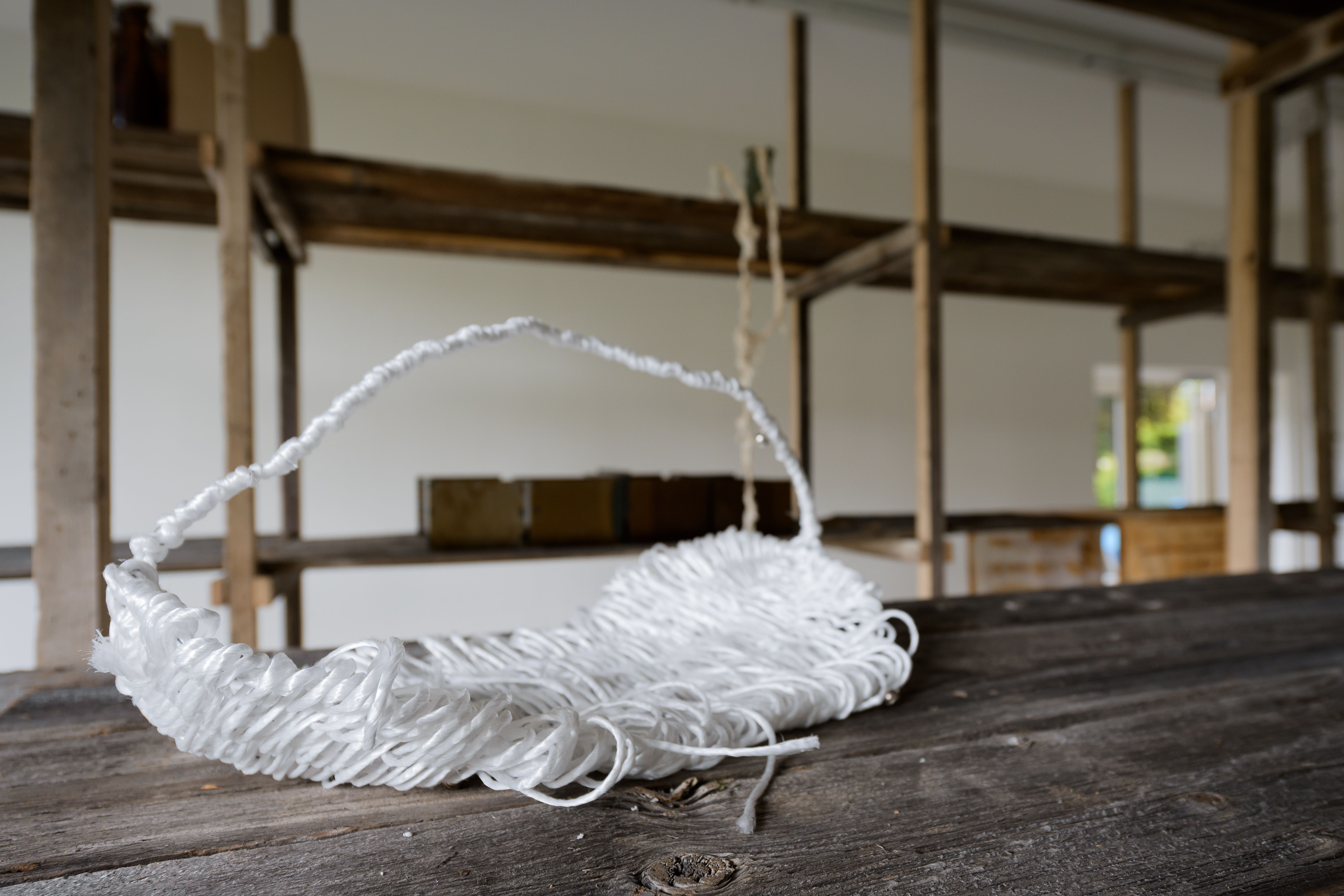
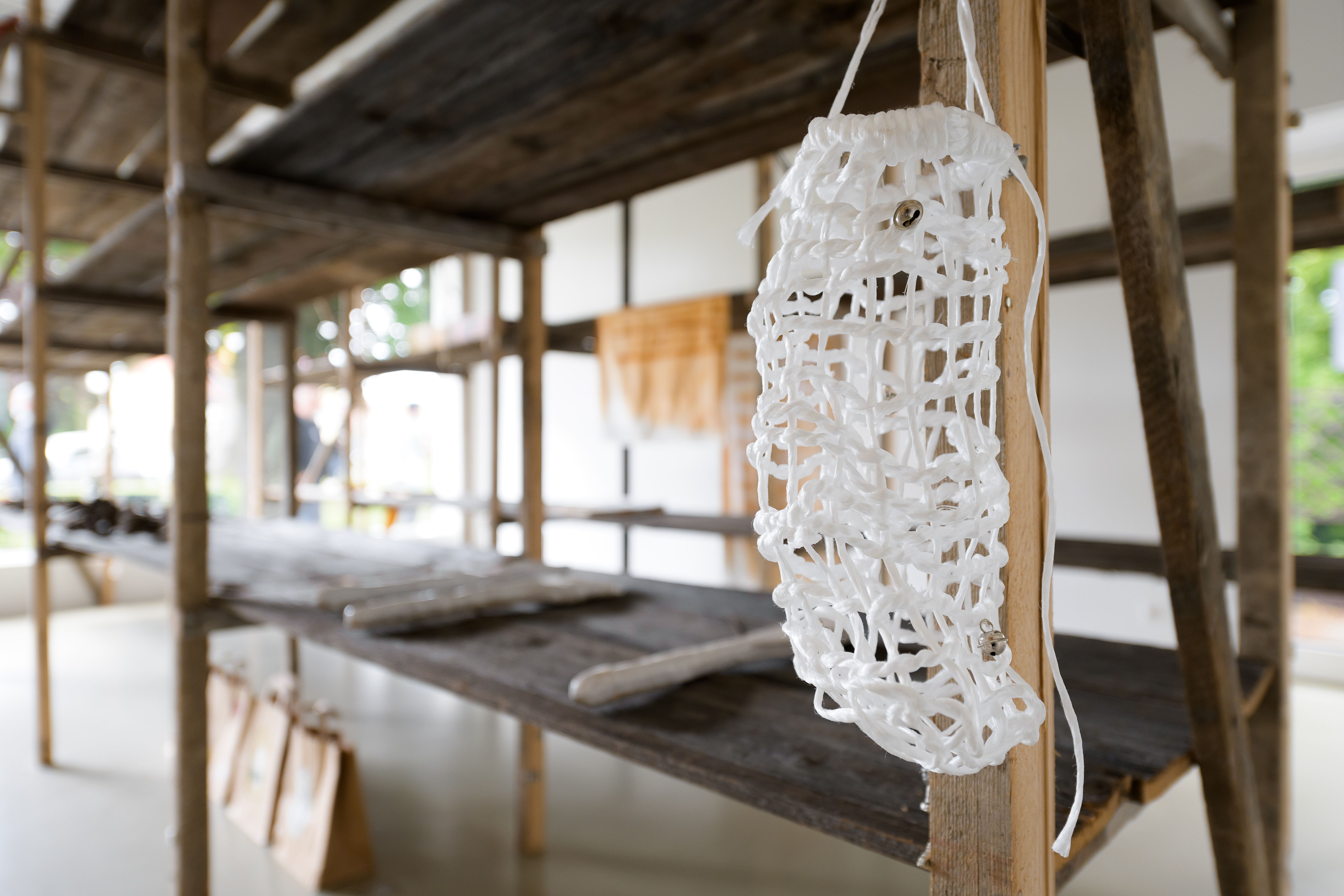
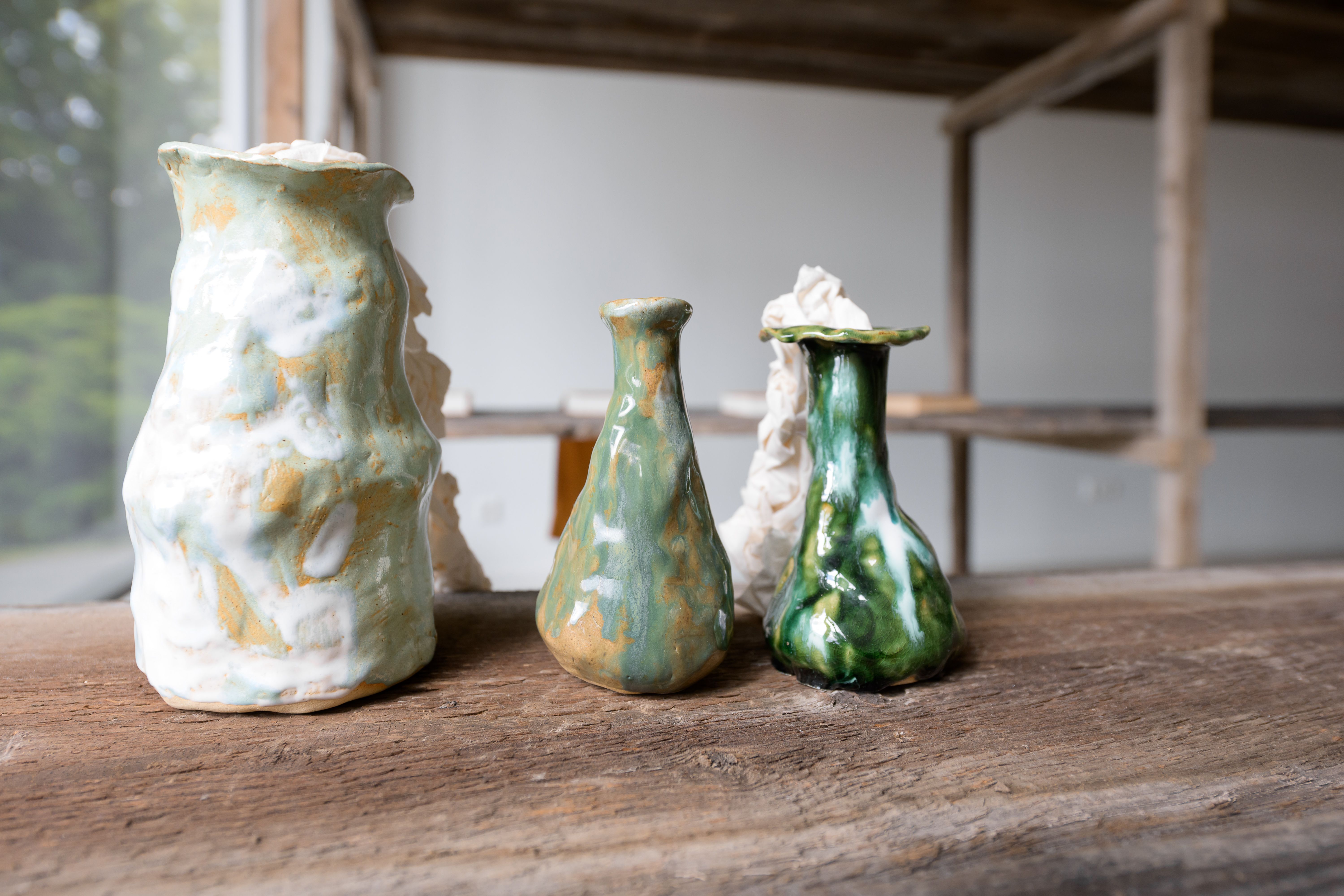
Chiara Mizaikoff, David Carol Fedders
Eine Erinnerung an dieses Dorf (A memory of this village)
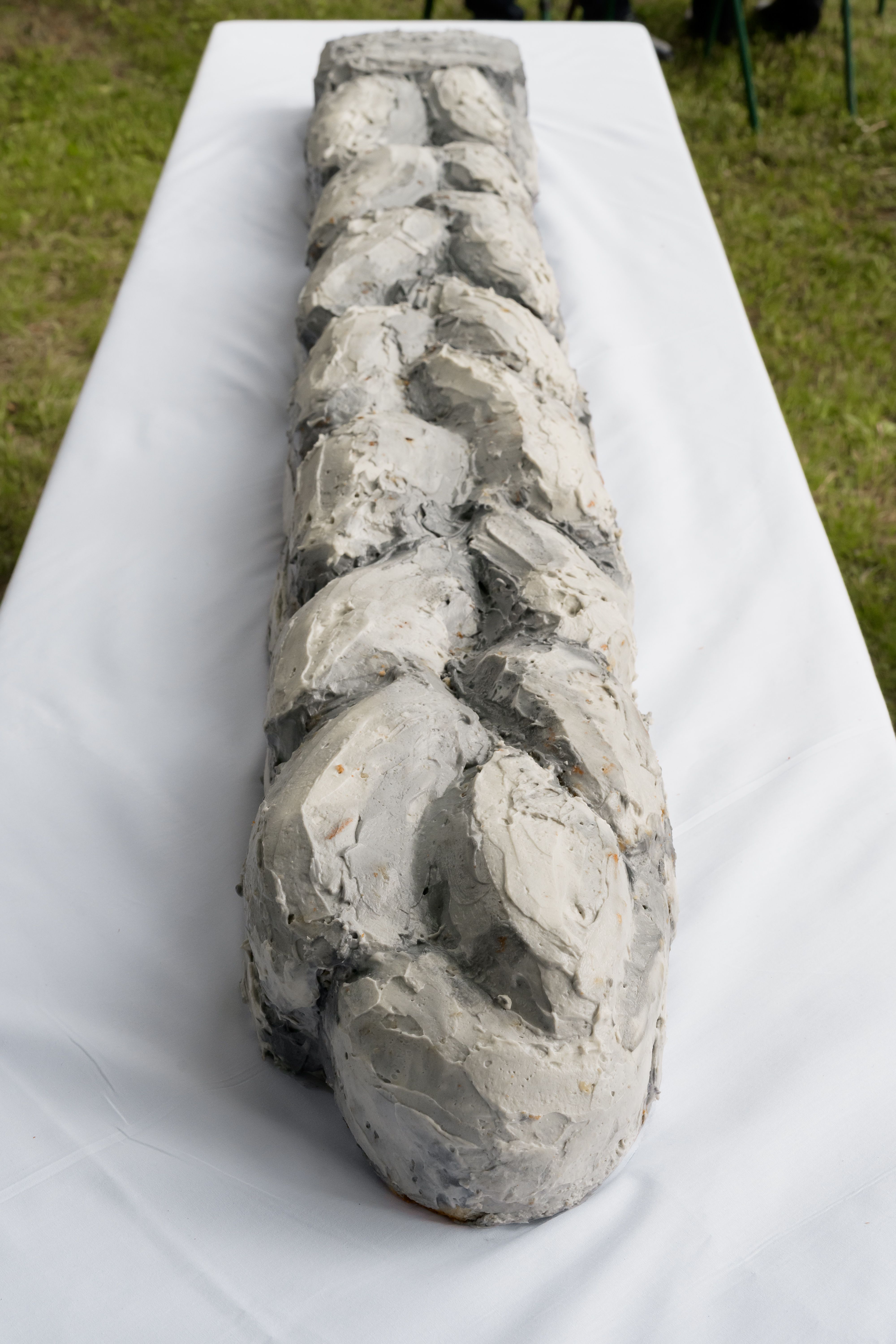
Chiara Mizaikoff, David Carol Fedders and four Weikendorf residents (Susanna Hirschböck, Maria Zillinger, Brigitte Kasper-Ager, Barbara Hollmann)
As part of the exhibition opening, Chiara Mizaikoff and David Carol Fedders invited the public to have a slice of the food sculpture they realized together with residents of Weikendorf. The sculpture took the shape of the Stein der Ähre, a local monument depicting a giant ear of wheat that was originally created in 1967 by a local priest and sculptor to mark 900 years of Weikendorf. The three-meter-tall, upright ear of wheat resembles a giant phallus that symbolically fertilizes the ground and, like a maypole, evokes an abundant harvest. In a blend of ritual and communal creation, Eine Erinnerung an dieses Dorf (A Memory of this Village) reimagined the monument not as a static commemoration of the past or a consolidation of a certain future, but as a living and participatory form in the present. The artist duo not only intervened in the script of the opening ceremony, but also renegotiated how art is produced, received, and shared. The half-scale, one-and-a-half-meter cake sculpture was baked using multiple ovens from local kitchens, uniting domestic labor with the public realm and transforming Kunstraum Weikendorf into a communal space. The artists thus picked up and continued to develop the project initiated by Michael Kienzer, who—rather than placing a public sculpture in front of the former fire station at Rathausplatz in Weikendorf, as originally intended by the public competition—proposed transforming the building itself into an exhibition space. Instead of adding another monument, this gesture created an open, ever-evolving space for art and discourse. In a similar spirit, Fedders and Mizaikoff’s food sculpture proposed a shift away from traditional public monuments toward new forms of engagement. At the heart of the opening celebration, the sculpture served as an offering that was shared and consumed by the artists, Weikendorf residents, and other visitors in an artistic eucharist. Traces of the collaborative baking process will remain visible throughout the exhibition as a memory of the cake feast. Through this ephemeral monument, new models of participation were proposed in which food acts as both a symbol and substance of community.

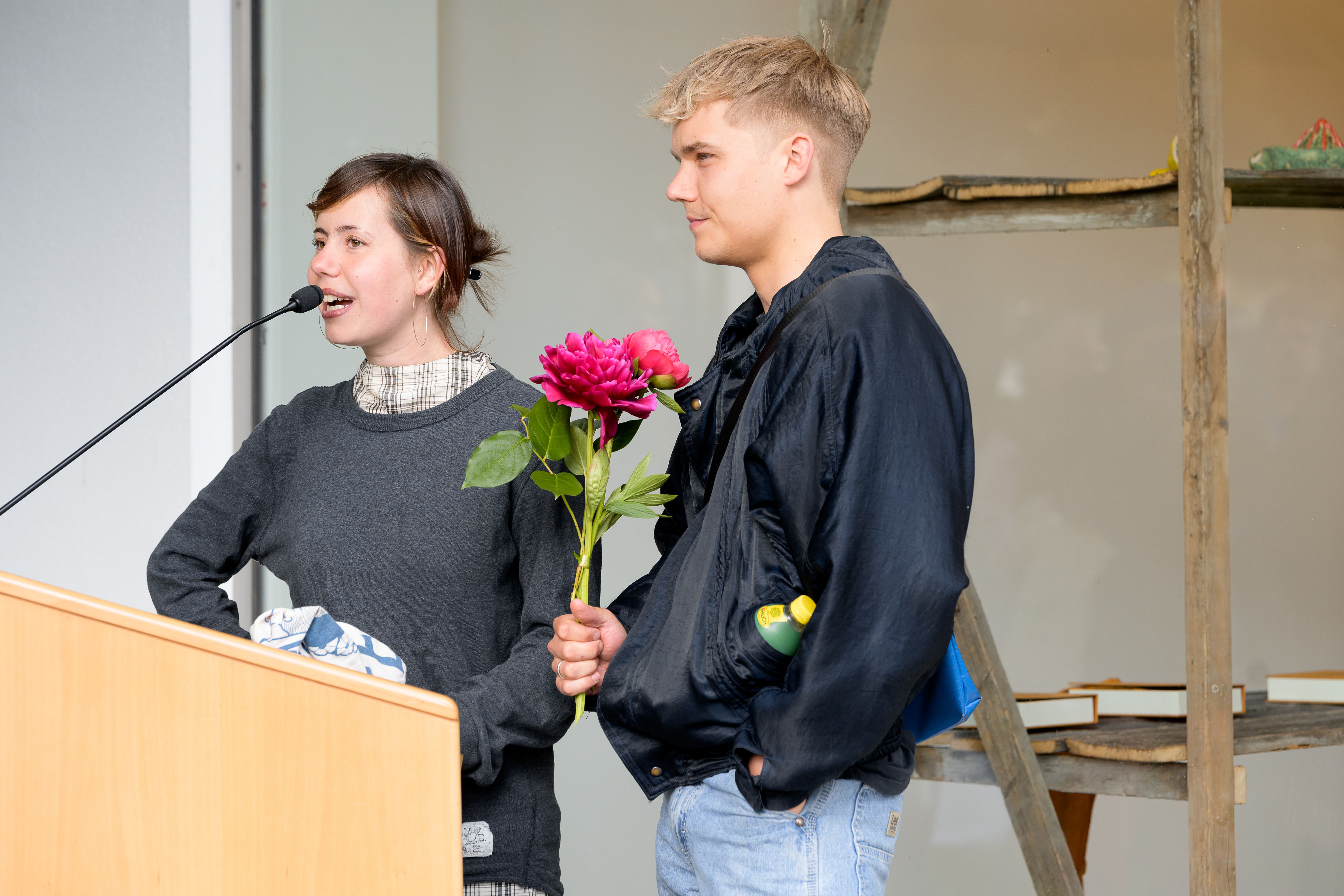
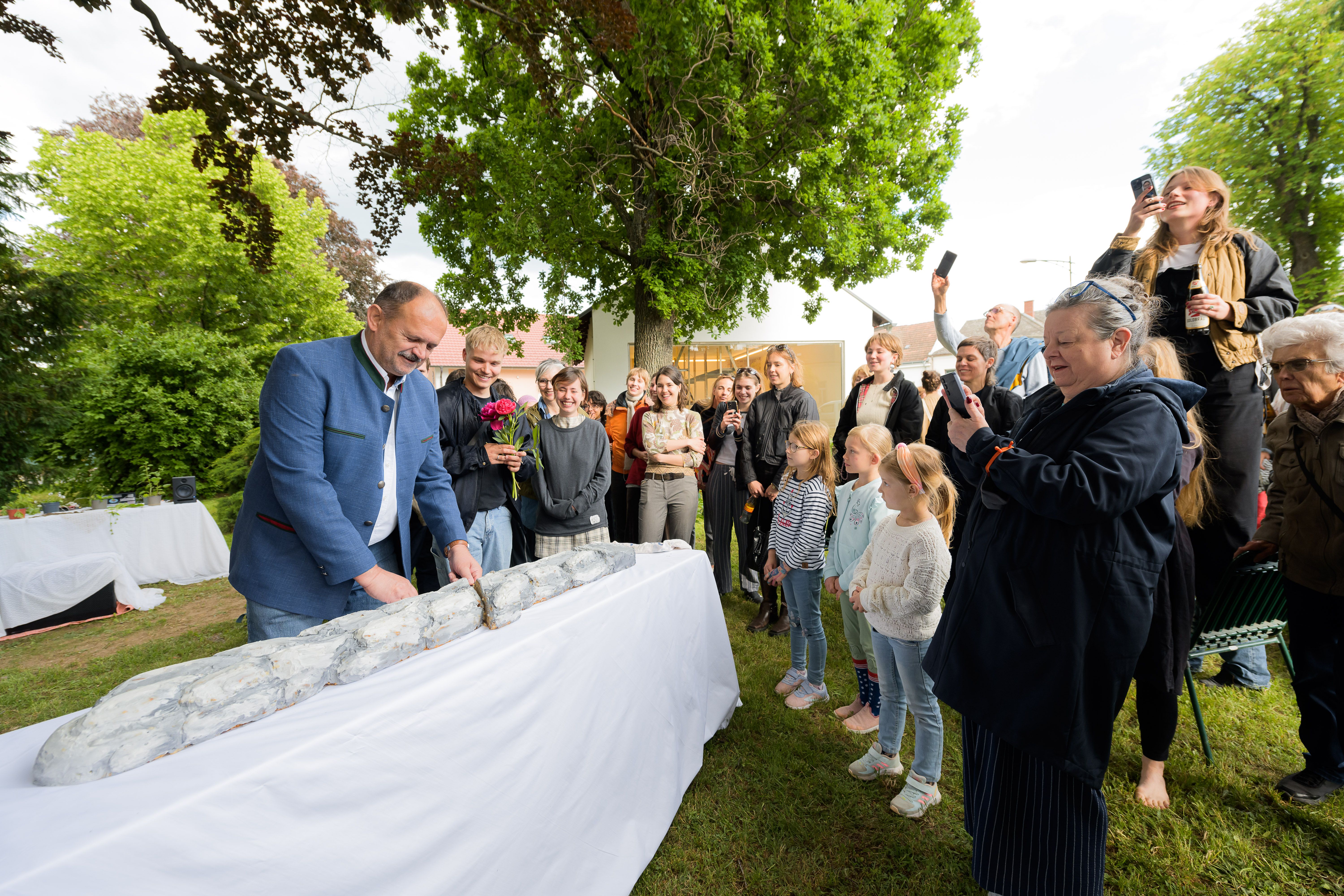
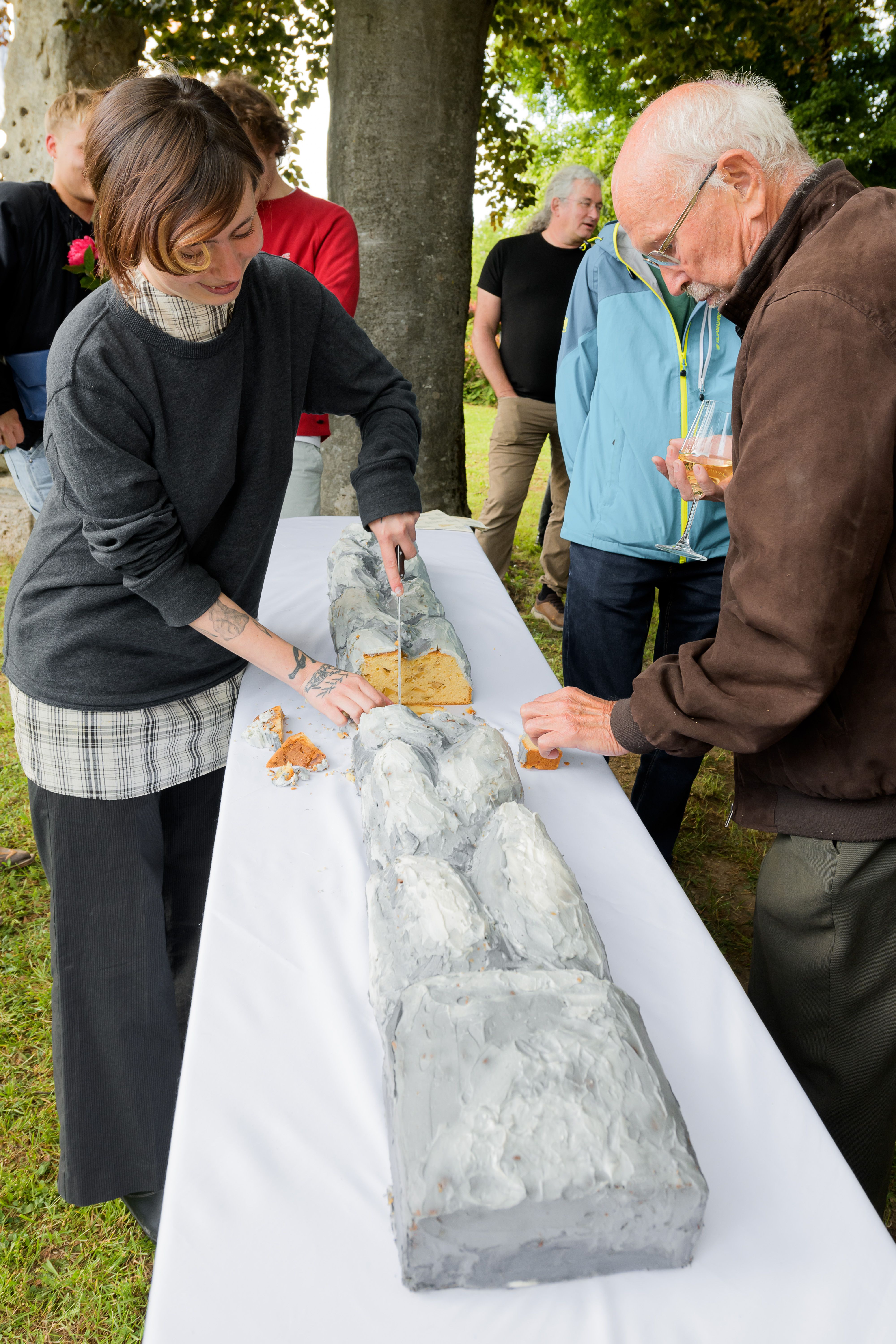
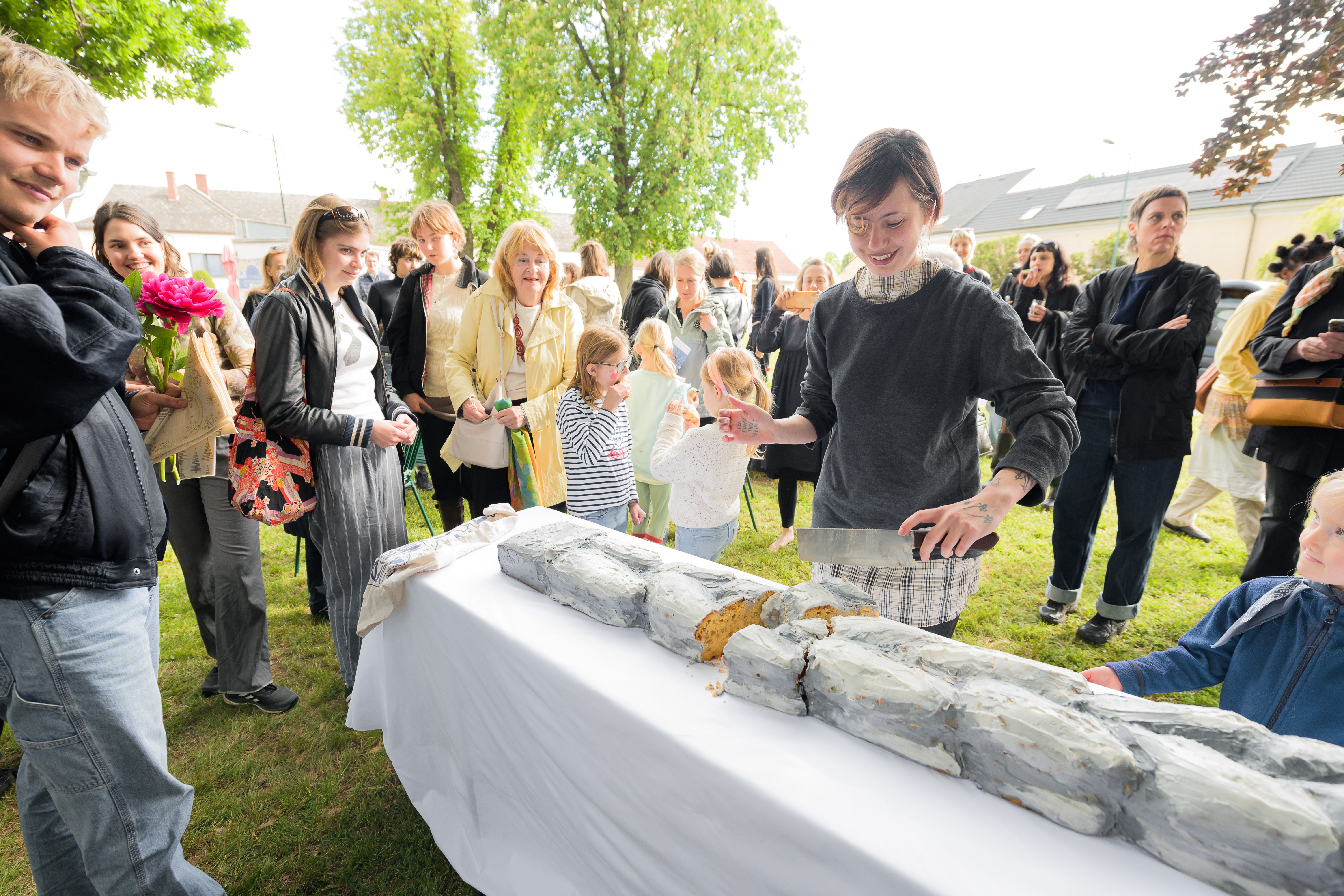
Marie Filippovits
Der Haussegen hängt schief (The house blessing hangs crooked)/Tapetenwechsel (Change of scenery)
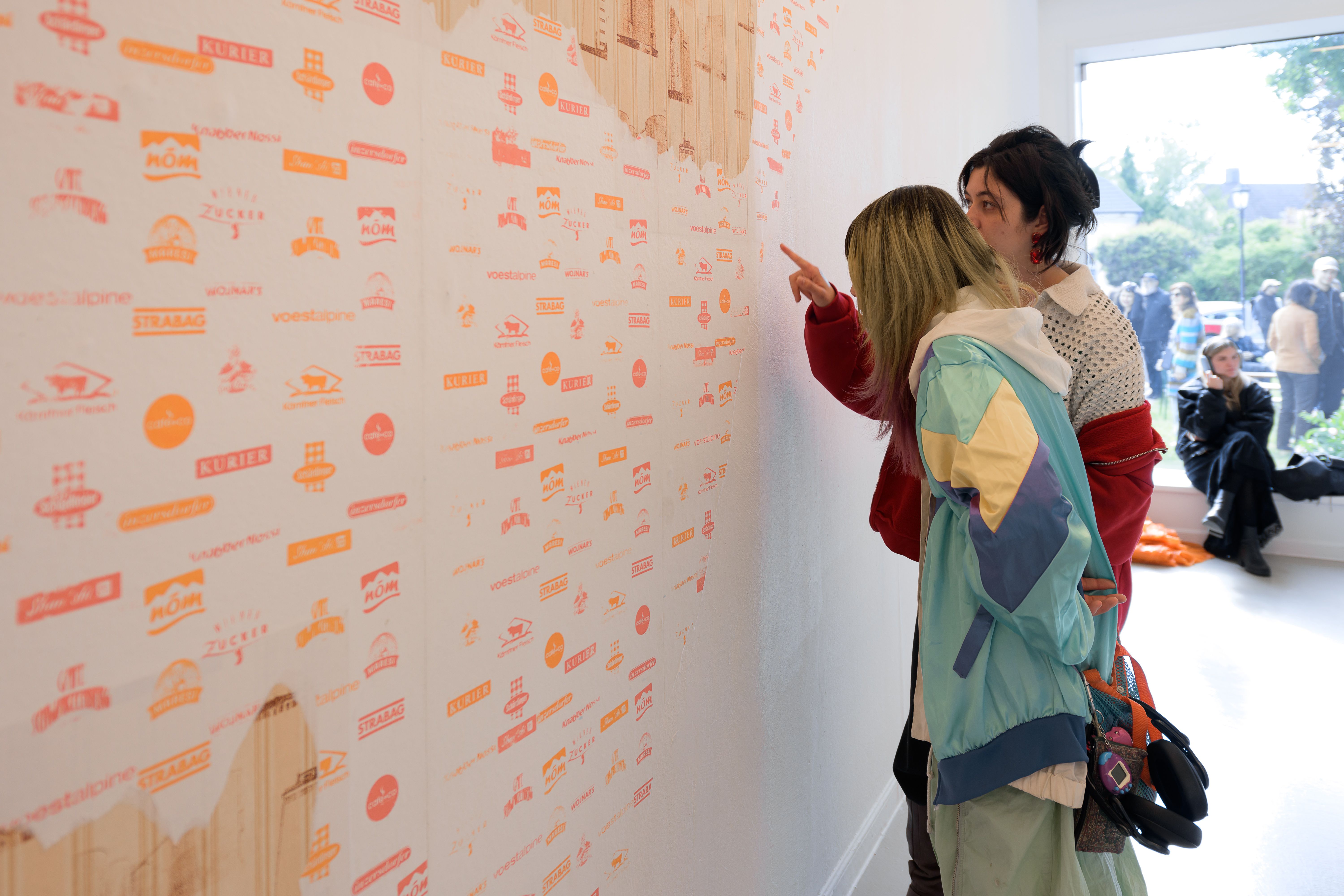
Marie Filippovits’ two related works, Der Haussegen hängt schief (literally: “The House Blessing Hangs Crooked,” a German idiom meaning domestic discord) and Tapetenwechsel (A Change of Scenery), critically examine the power dynamics and structural shifts within Austrian agriculture. A sugar-cast gable cross, referencing both the Raiffeisen Bank logo and the recently closed AGRANA sugar factory in Leopoldsdorf (in which Raiffeisen holds shares), hangs askew. In its upright form, the cross evokes the so-called “Trinity”: the longstanding alliance between the center-right ÖVP party, Bauernbund (Farmers’ Association), and Raiffeisen in Lower Austrian politics. Once mounted on the roofs of houses to protect occupants from dangers, the gable cross here reflects the ambiguous role of Raiffeisen, which was initially founded as a cooperative to shield farmers from agrarian crises and market pressures but now operates according to market-driven, managerial decisions, with unclear impacts on farmers and agricultural laborers in the Marchfeld region. Filippovits sheds light on the porous boundary between care and control, protection and profit-making. In the mural Tapetenwechsel, the artist overlays images of four closed, vacant silos in Gänserndorf, Mannersdorf, Oberweiden, and Leopoldsdorf with logos of food and media brands that are owned or co-owned by Raiffeisen. The artwork thus raises questions of transparency by examining what we can, and cannot, see of the production chains that shape our food systems and everyday lives, and what infrastructures we choose to grant our attention. Like industrial monuments, silos, which are sites for the intermediate storage of harvested crops, are highly visible from the outside, yet offer little to no insight as to what occurs within. The superposition of the two wallpapers further reveals a shift away from investment in agricultural infrastructure toward corporate consolidation and shareholding, pointing to the increasing dominance of mega-brands in the shaping of Austrian agriculture.

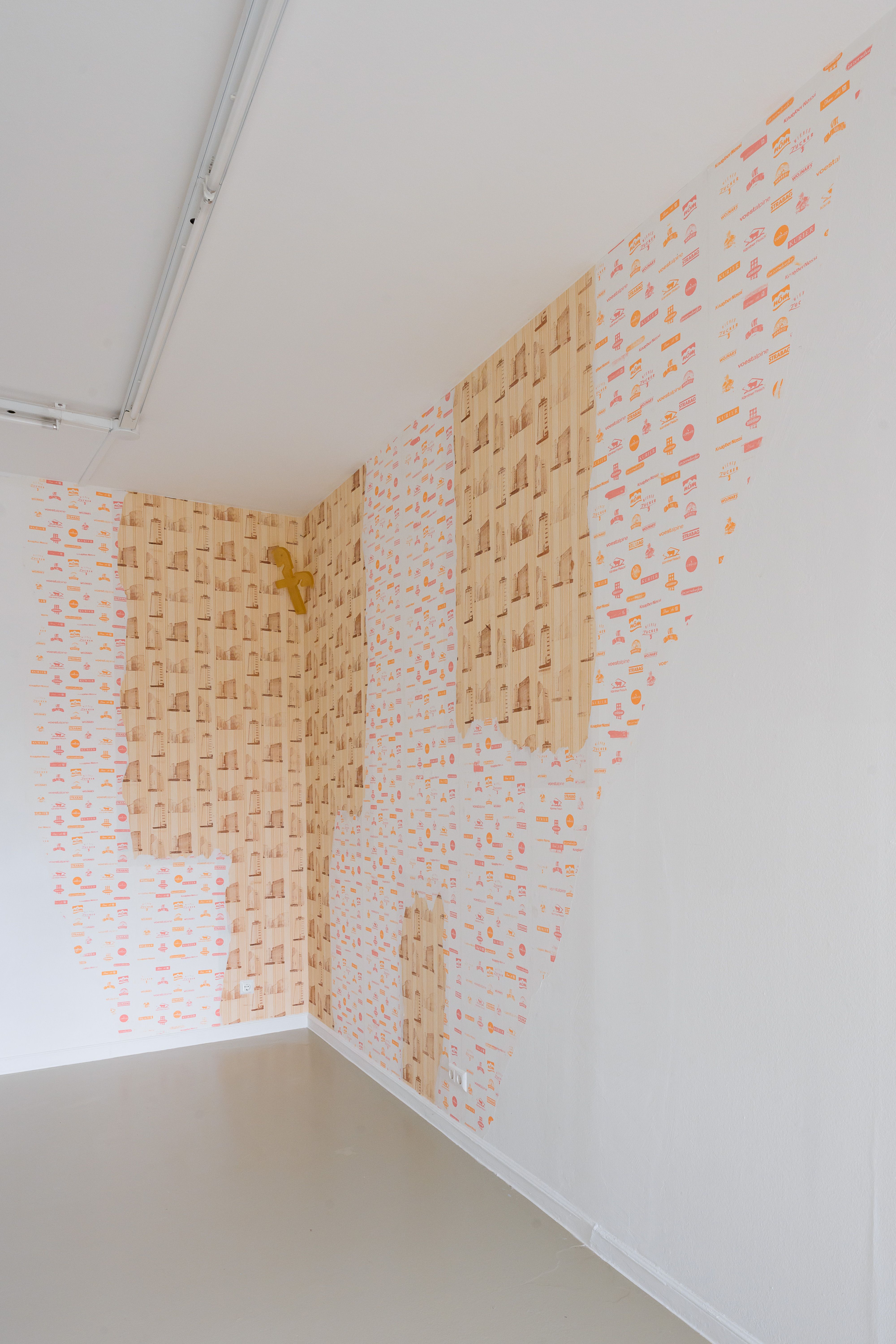
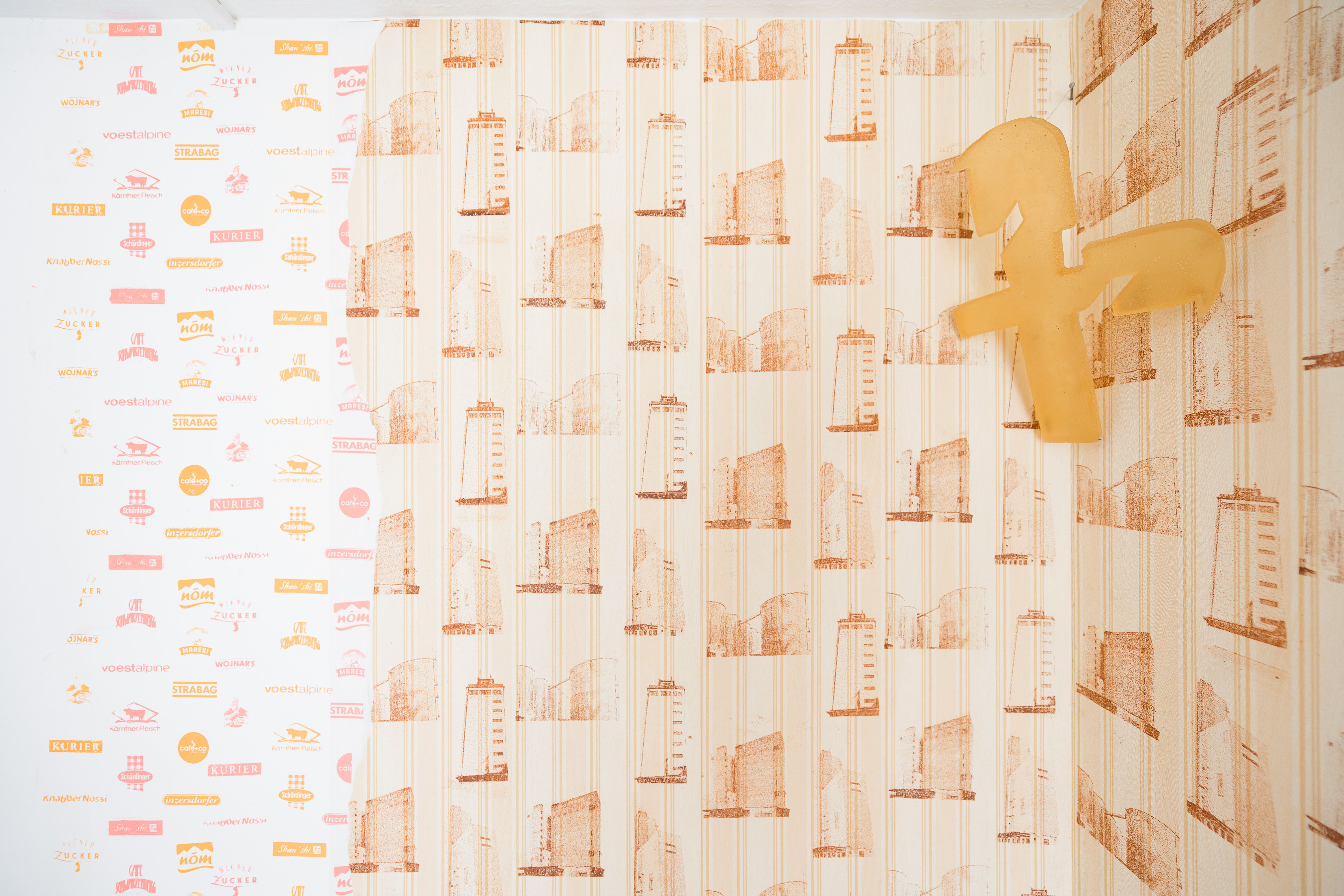
Images (25)
